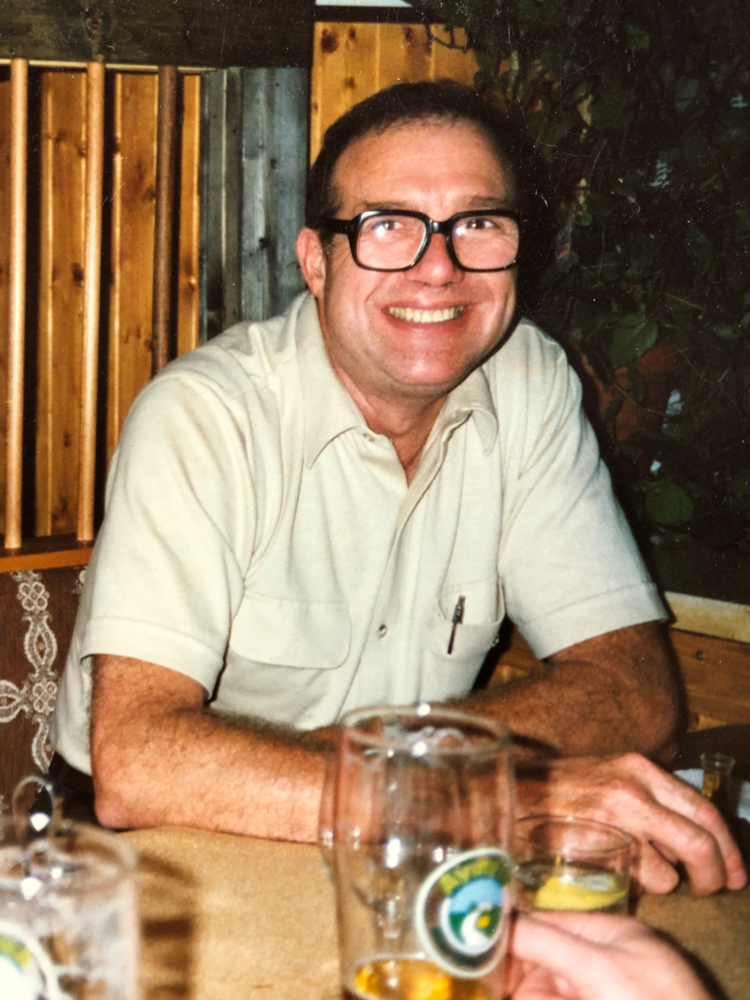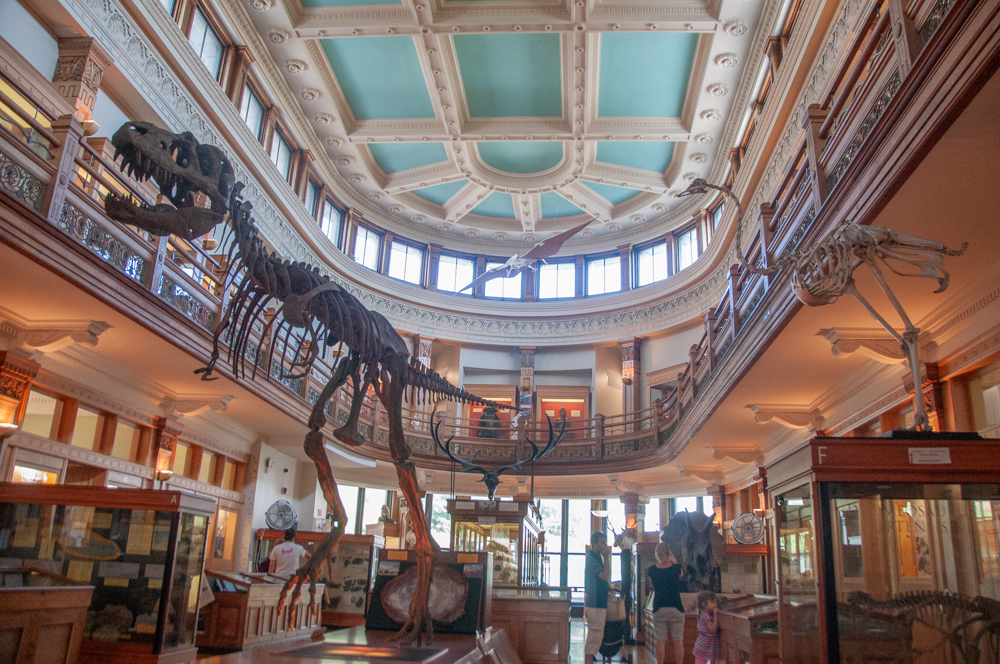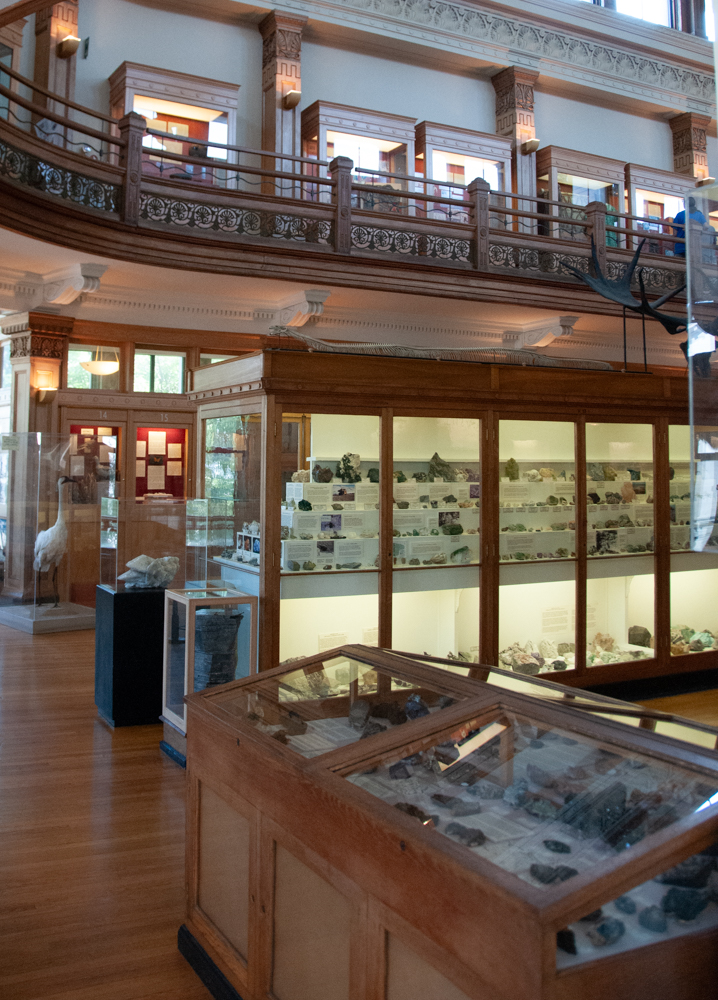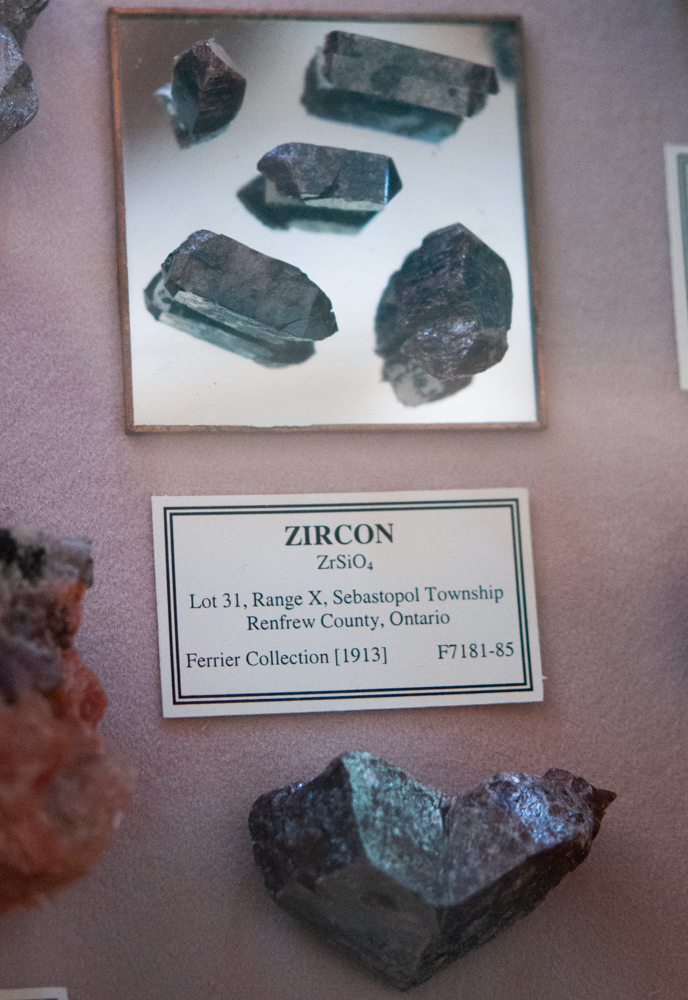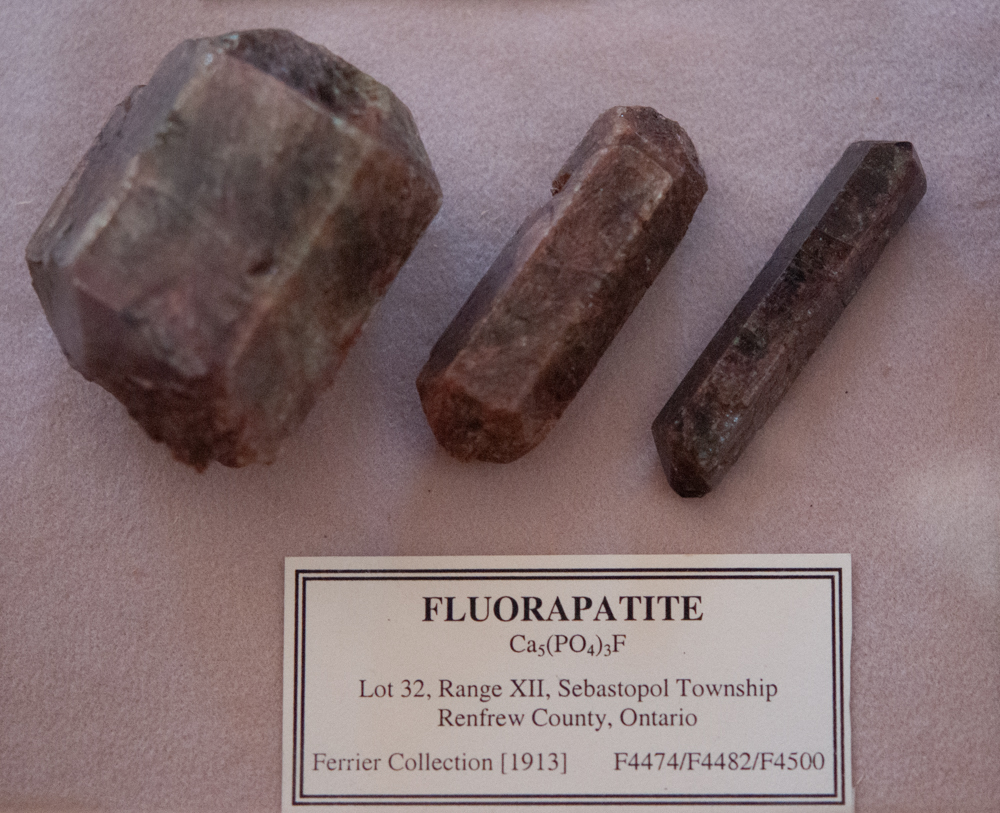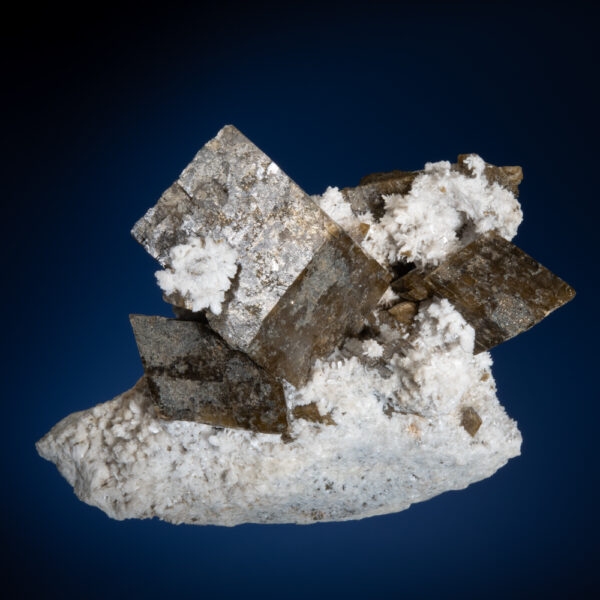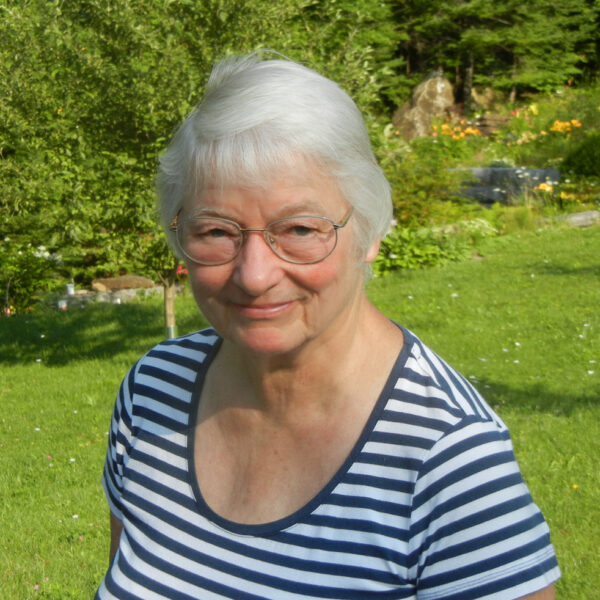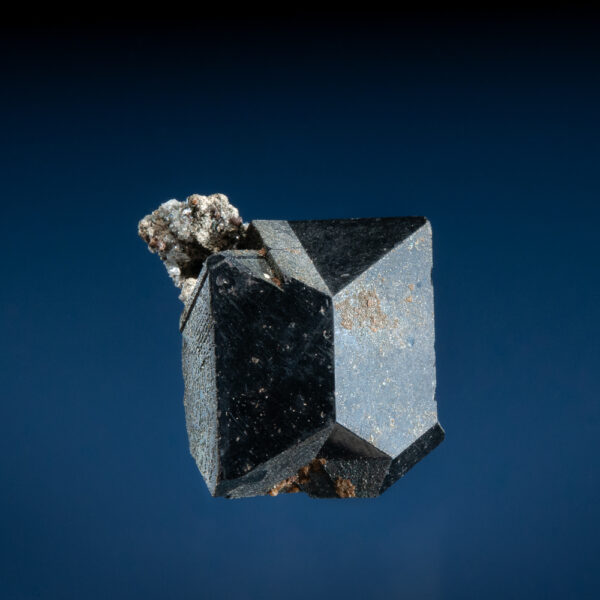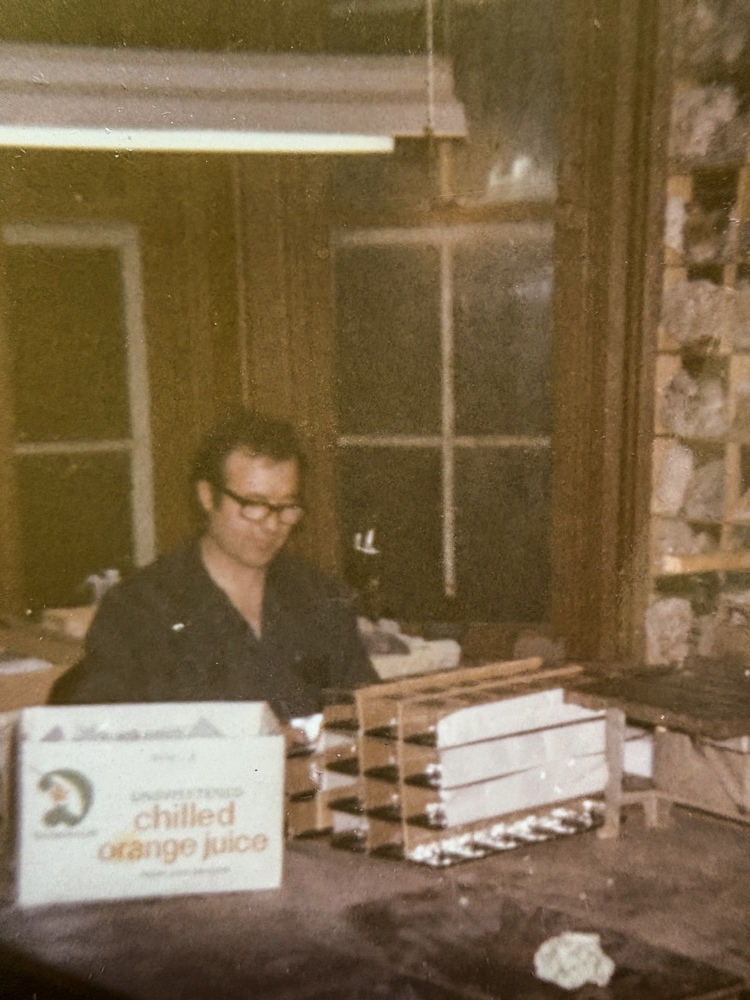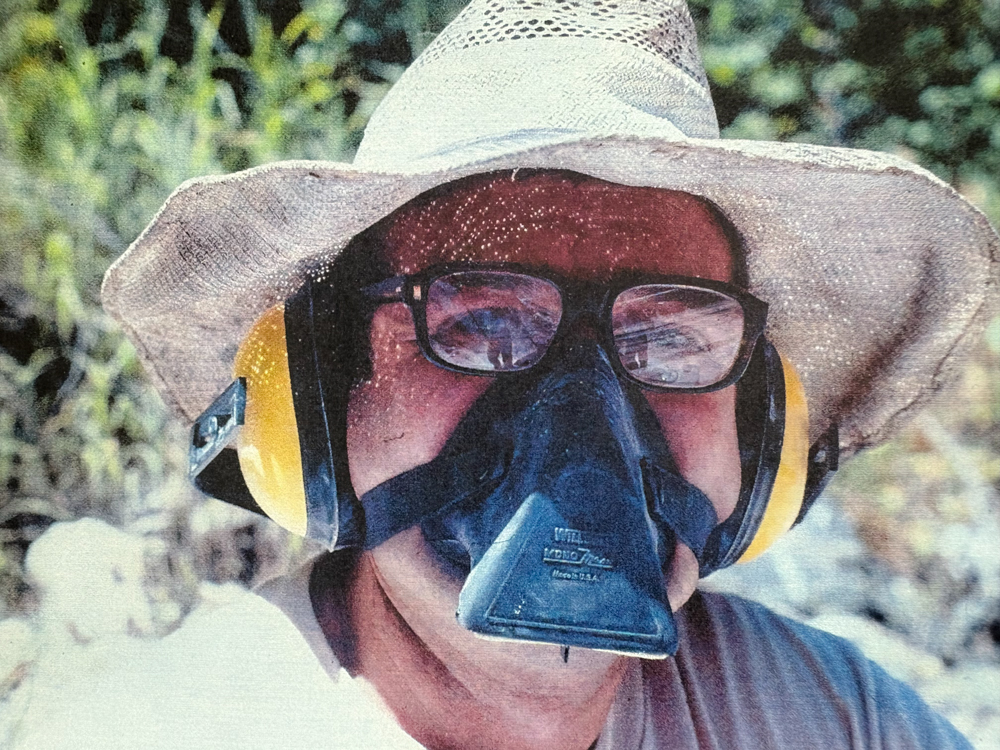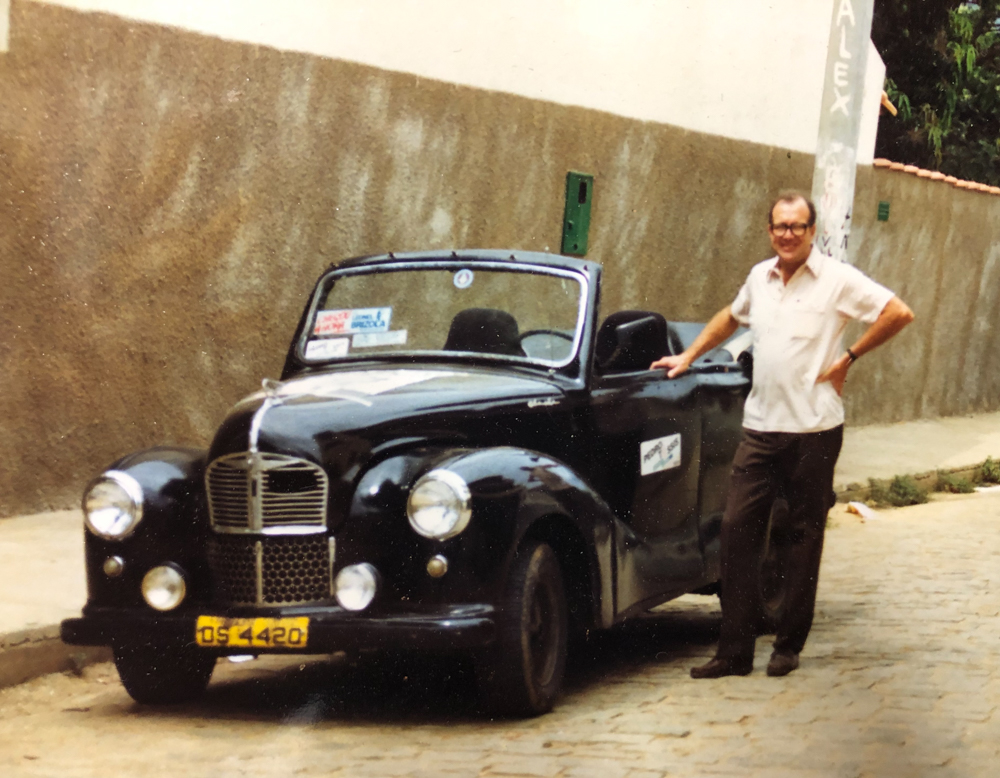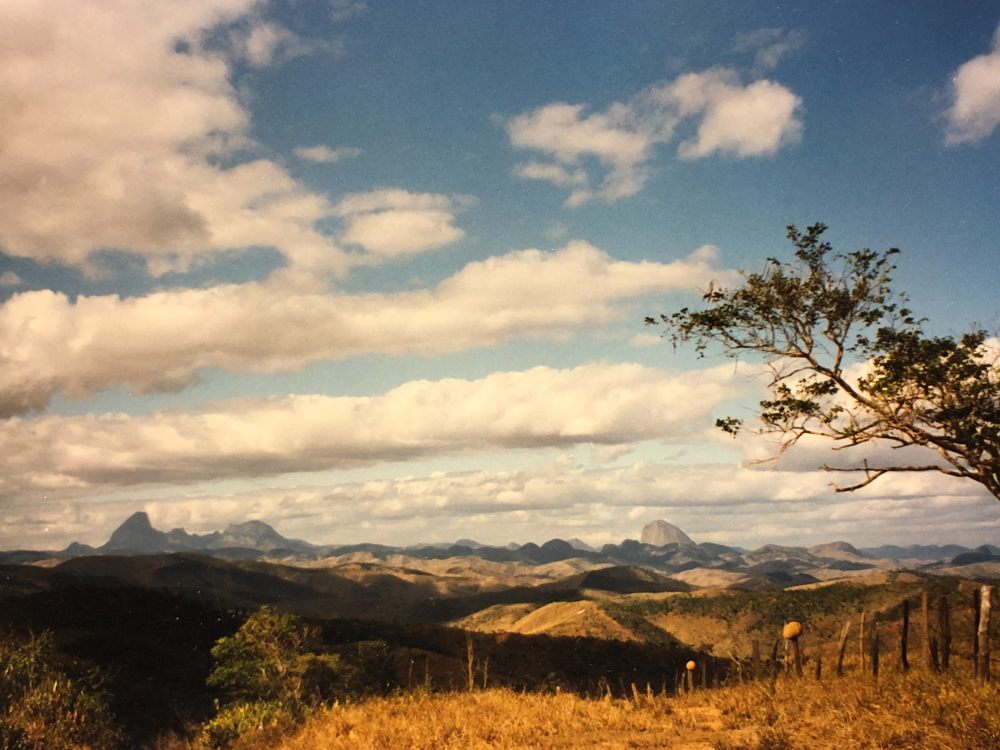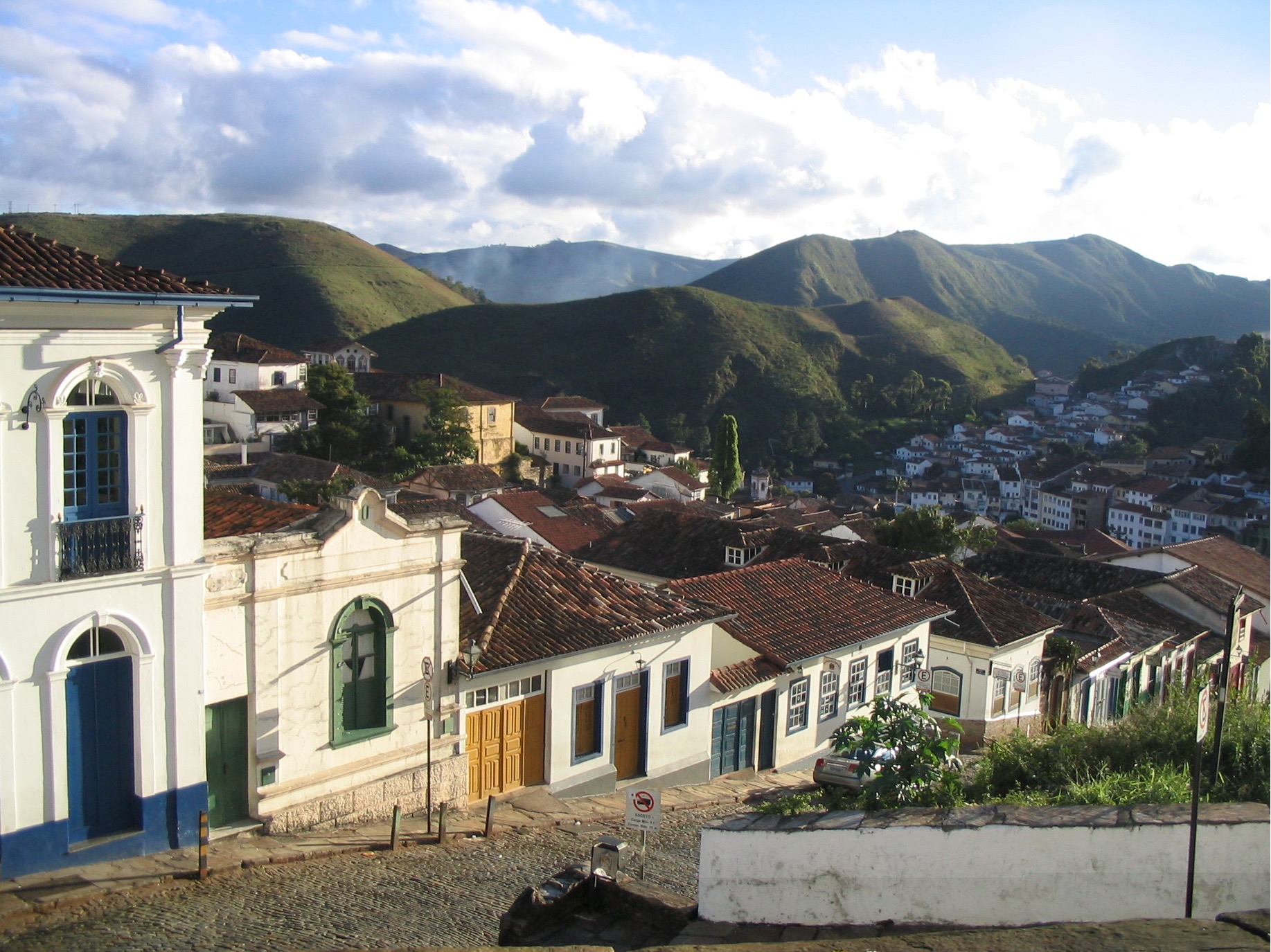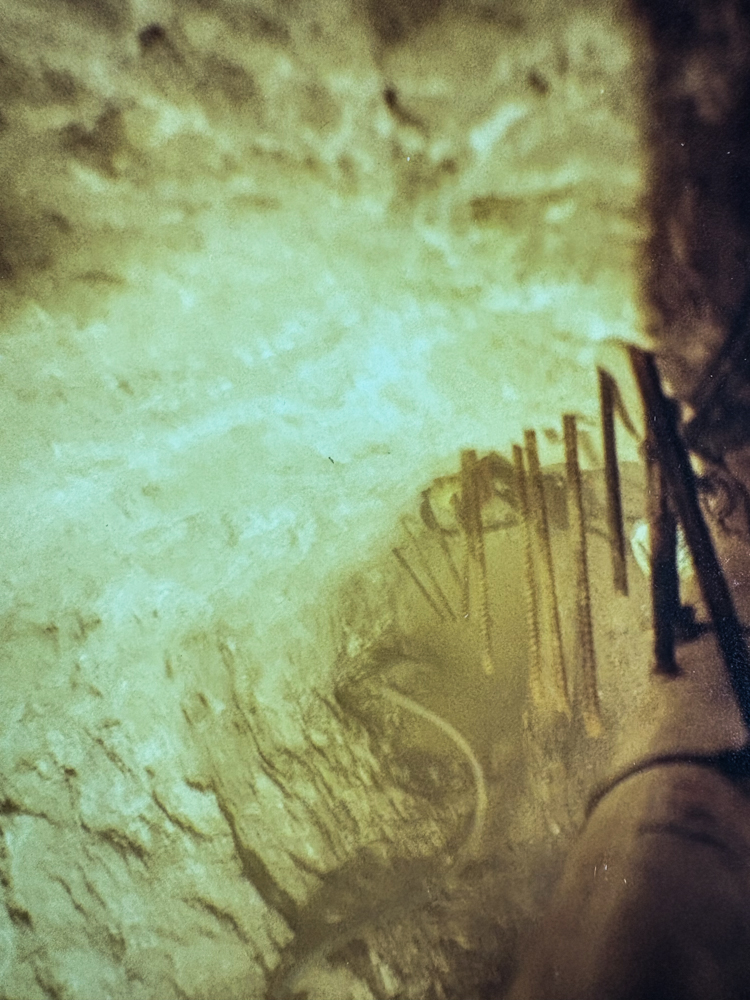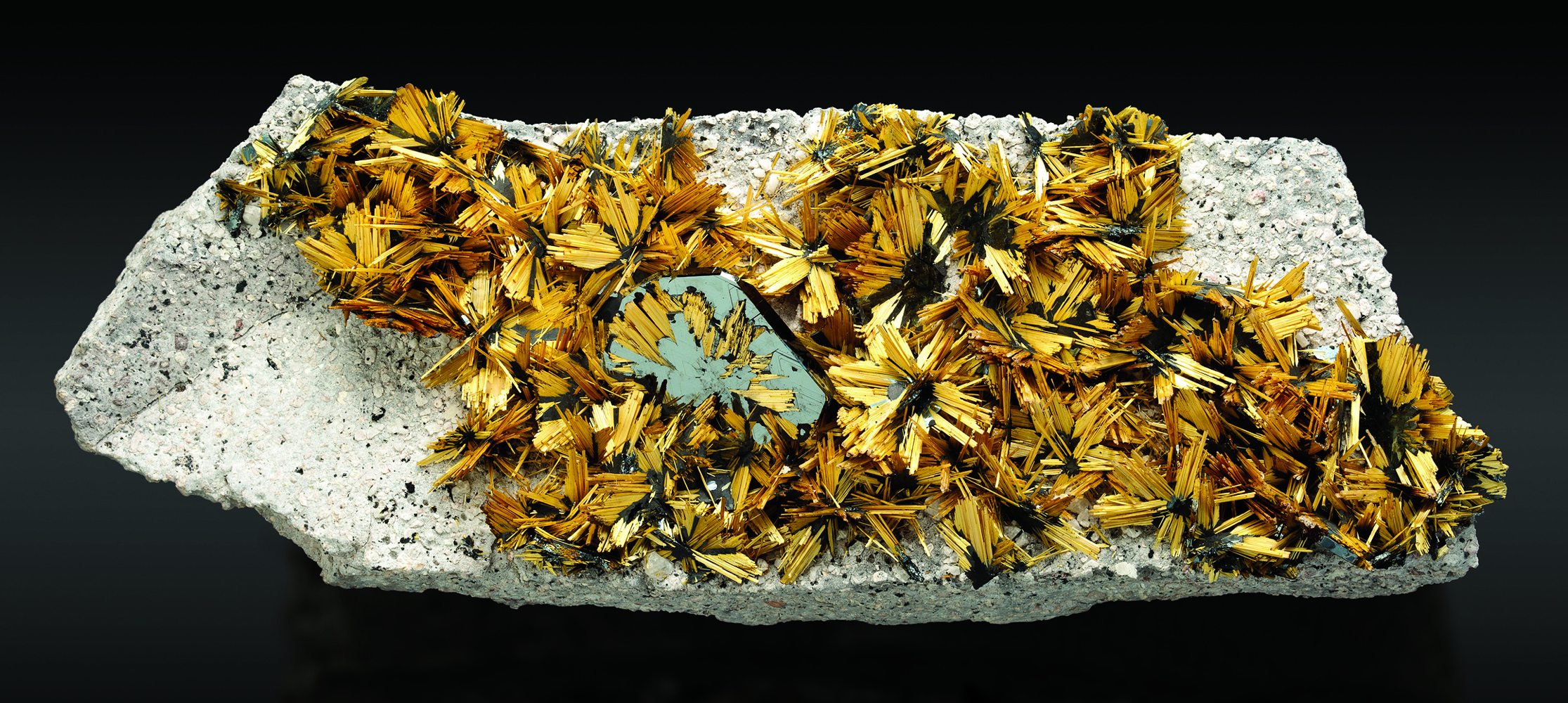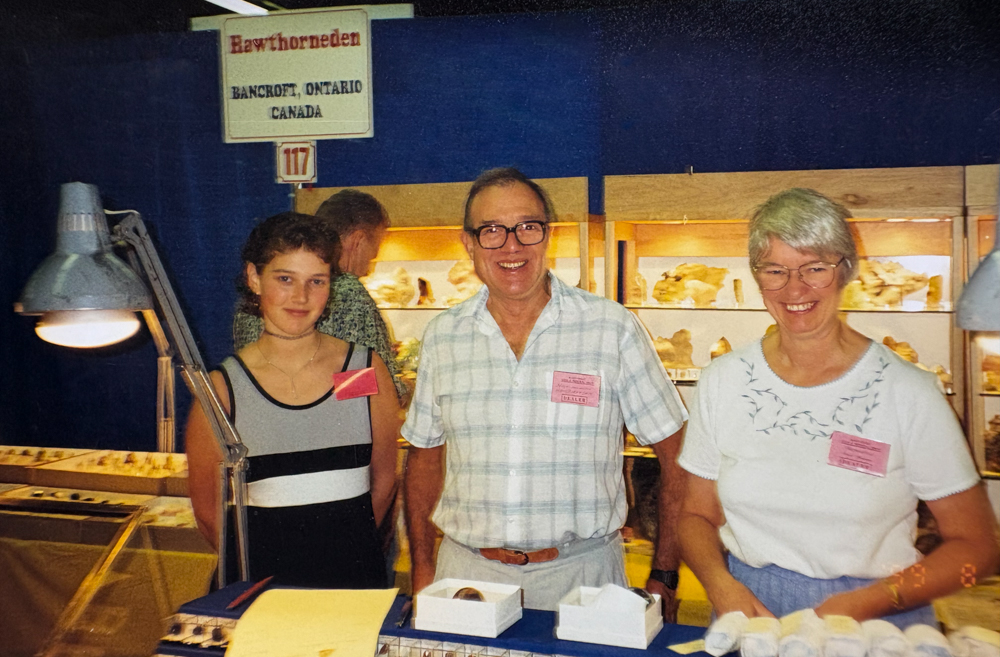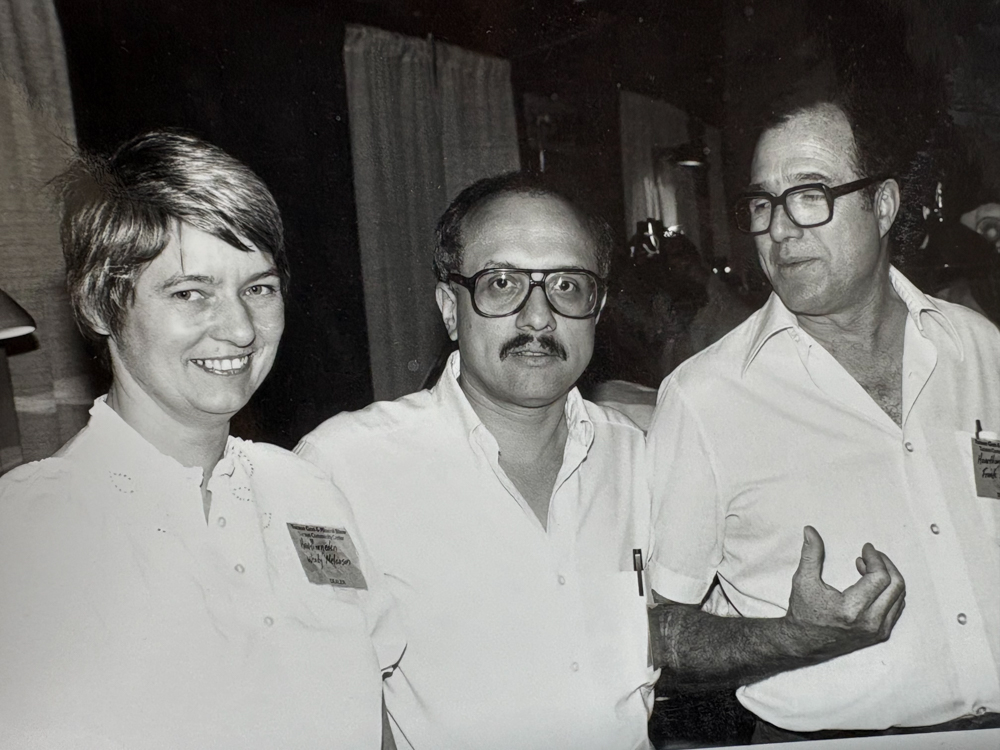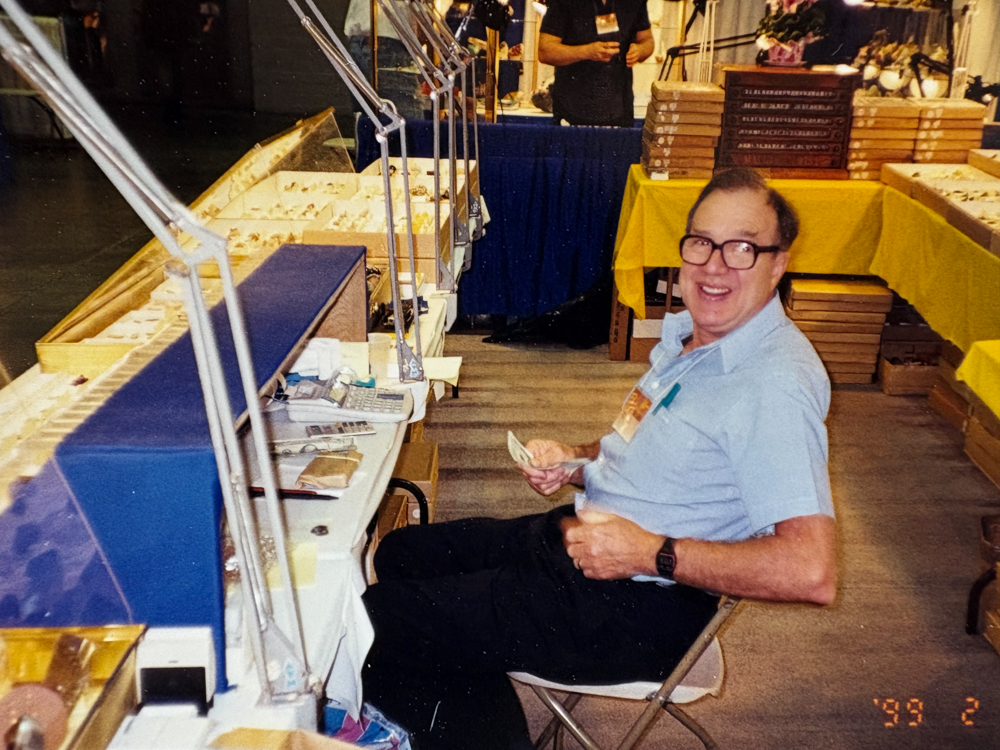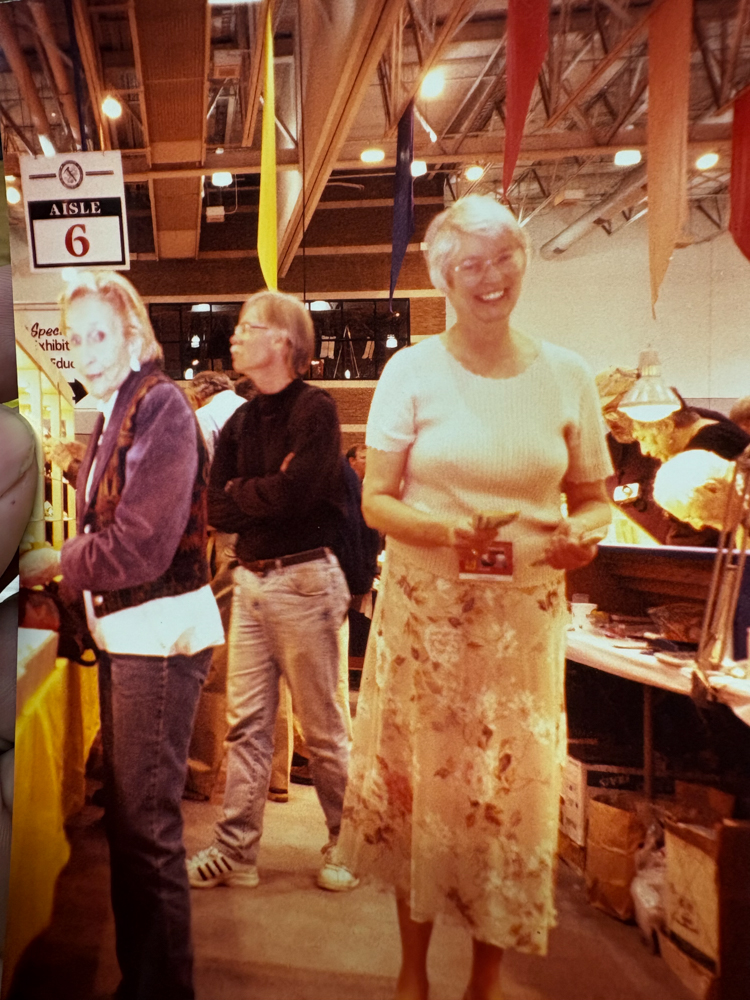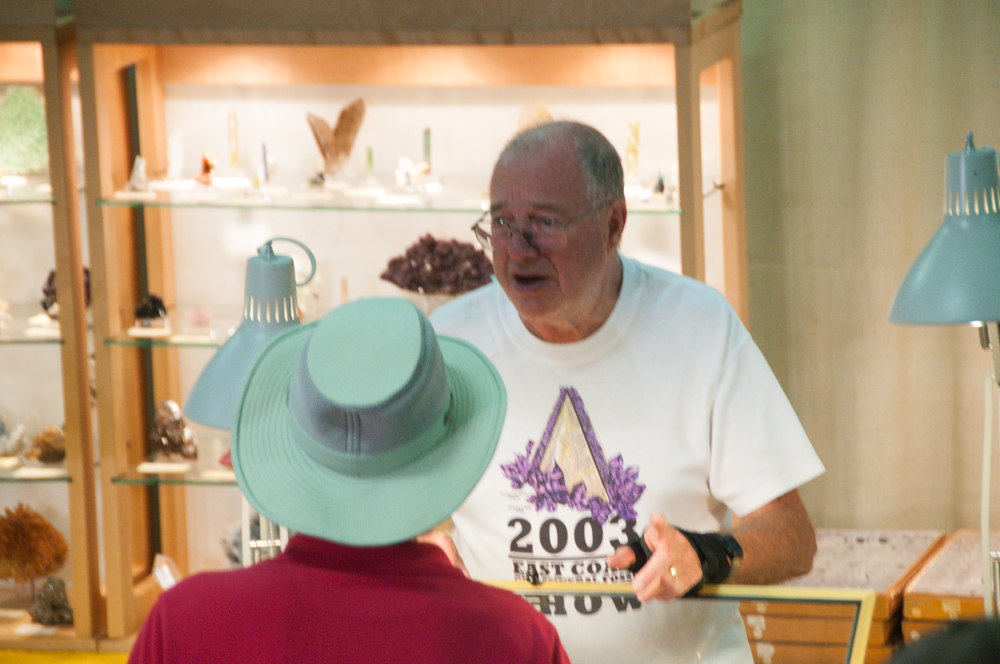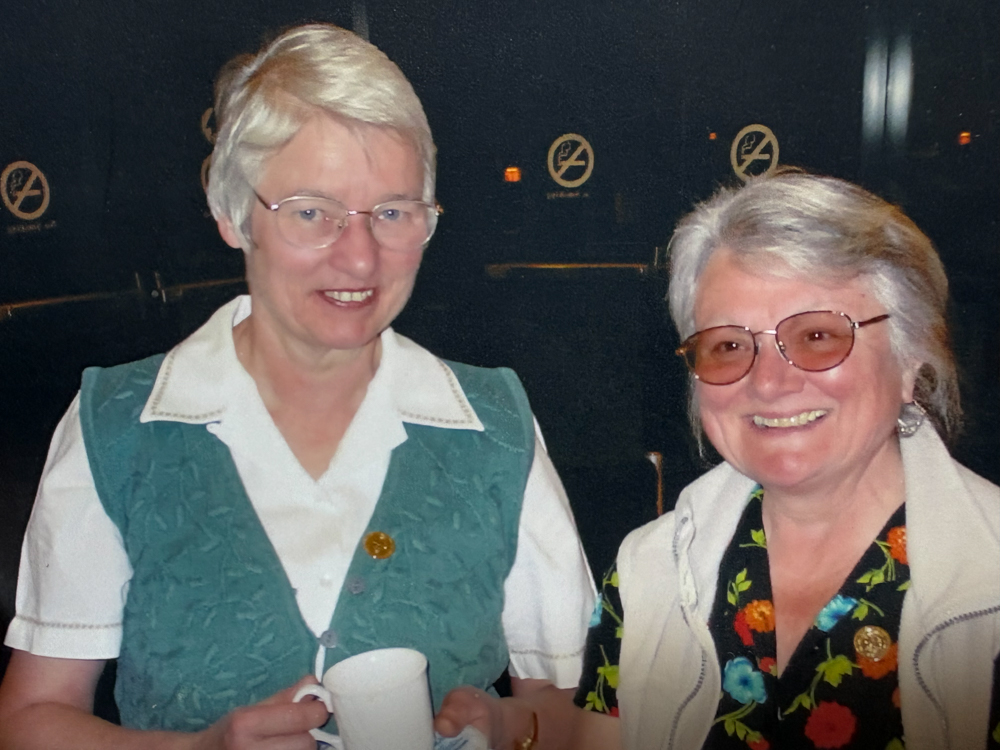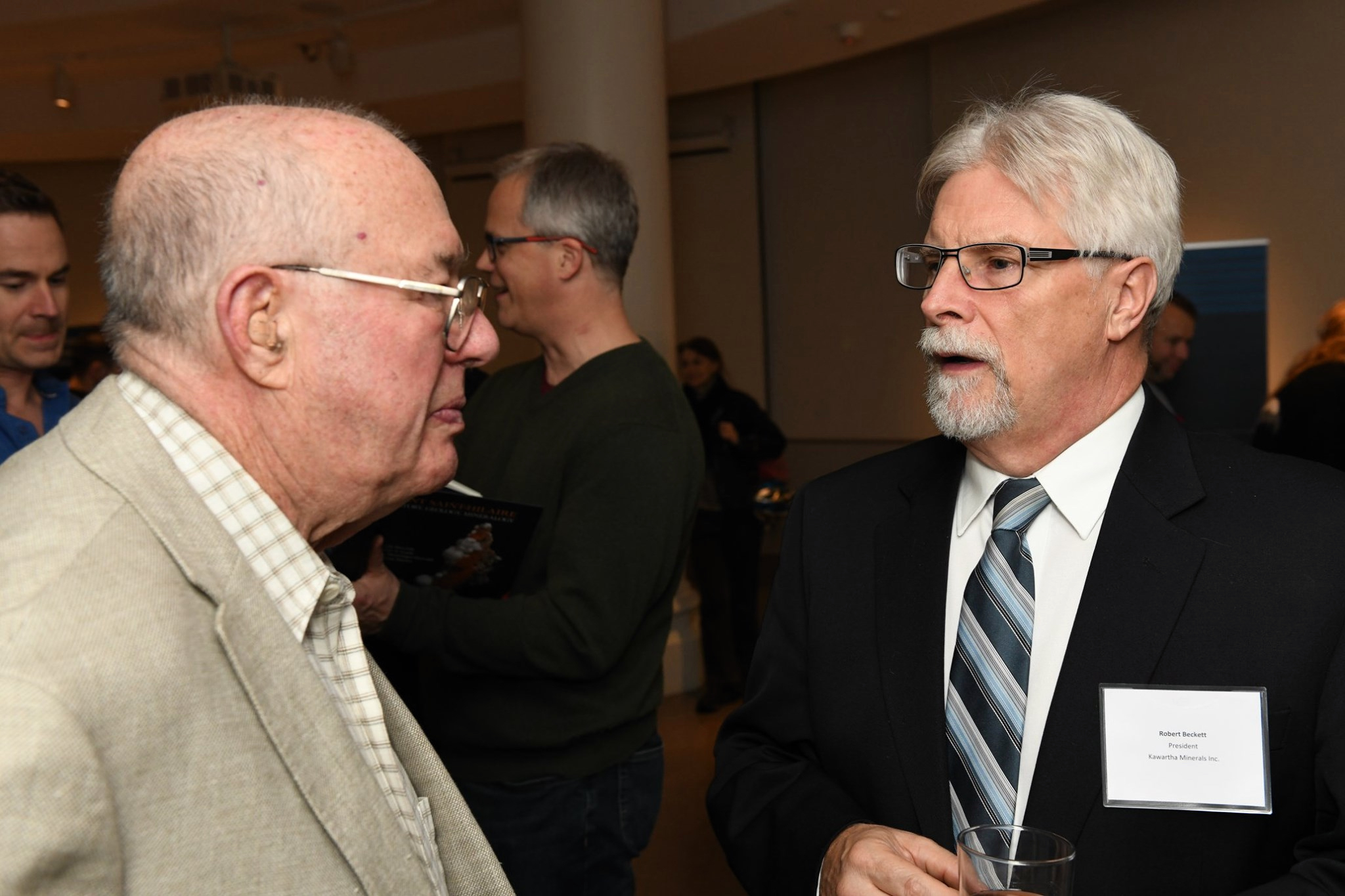Categories
Archives
Many of you already know Frank and Wendy Melanson. If you do, I hope you’ll find some of the photos and stories new, and if you don’t, I hope this will be a fun read about two longtime members of the mineral world who have been friends of mine for almost as long as I can remember.
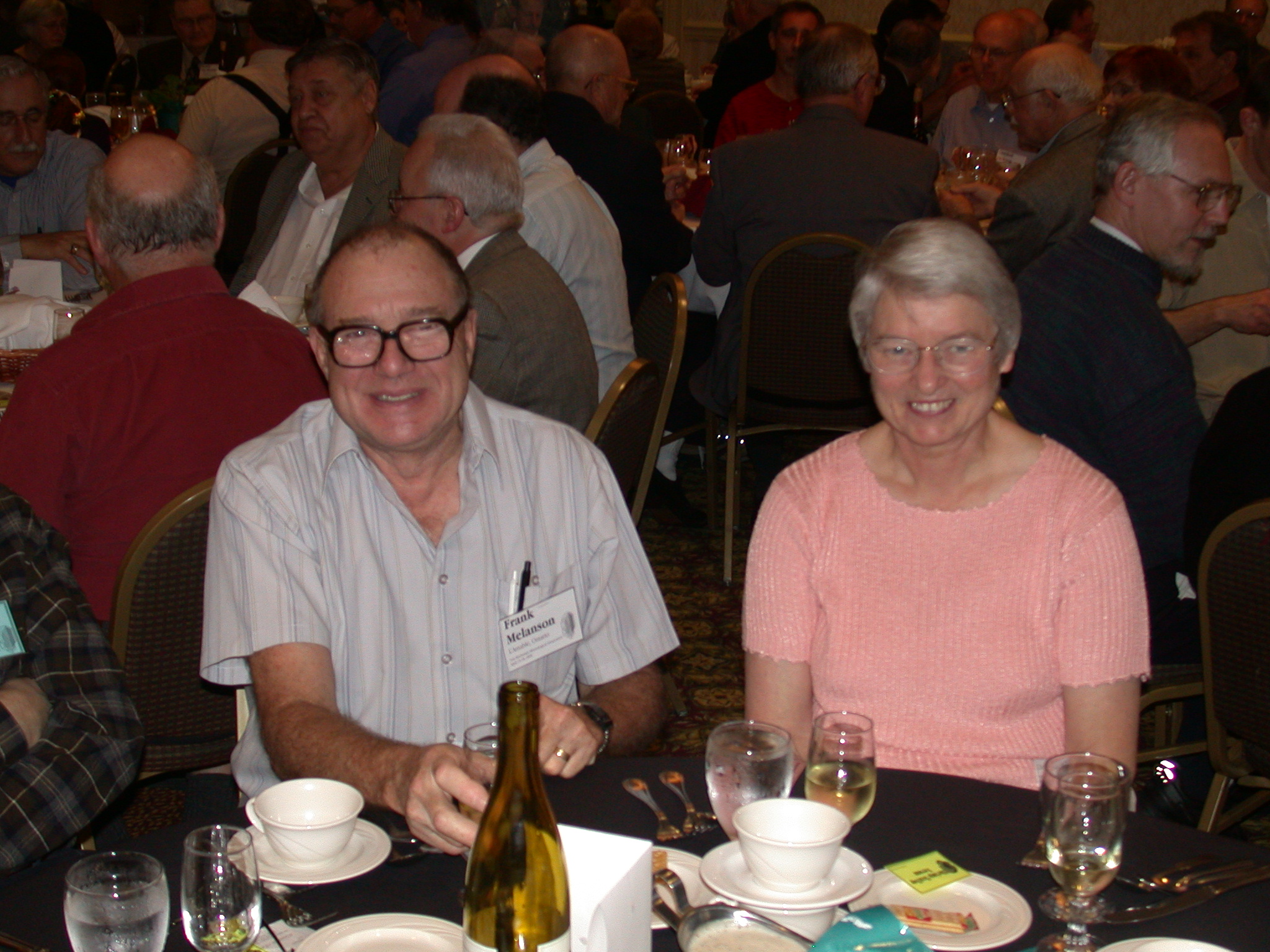
Frank and Wendy at the Rochester Mineralogical Symposium, 1994
Jeff Scovil photo
Frank and Wendy were Canada’s prolific dealers in international minerals, under the dealership name Hawthorneden, for over 40 years – travelling the globe for minerals, and setting up at shows across North America and abroad. From extensive in-country travels, Frank brought back superb specimens that their business placed into museums and collections worldwide. Frank and Wendy developed friendships throughout mineral world, and and over the years they truly enjoyed minerals through their personal collections.
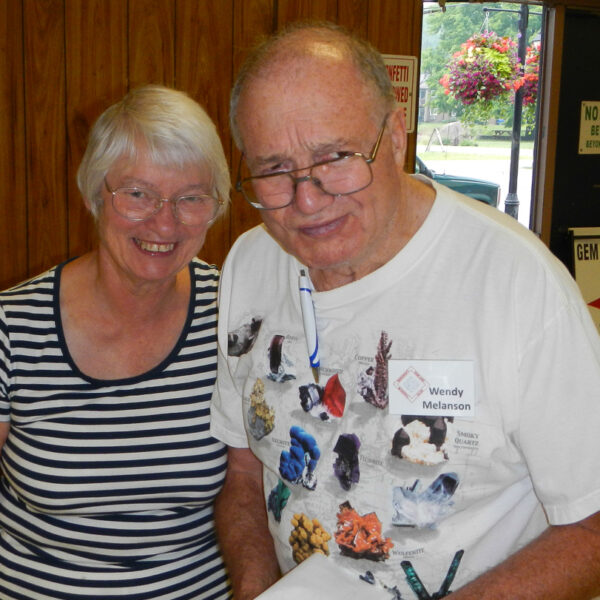
Frank and Wendy at the Bancroft Gem and Mineral Club Show, 2014
But there’s more to this story, and a deeper motivation for me to write it. I first met Frank and Wendy in the early 80s, and Frank started to be an influential mentor to me starting around 1988. Ultimately he became one of the most influential mentors and mineral friends in my collecting life. And Wendy and I have enjoyed sharing a very similar appreciation of specimen aesthetics, having looked at countless specimens together.
It has taken me all this time to drag the stories and photos out of Frank, bit by bit. And now I’d like to share them, so that you can enjoy them – and some of the contributions Frank and Wendy have made in the world of minerals – starting in the 1960s, into the 2020s. Seven decades!
This particular version of the story starts with Frank. And one theme runs throughout: Frank’s adventures, risks, business, and many other travels all arose because Frank genuinely loves minerals.
Frank – Early Years
Frank was born in Moncton, New Brunswick in 1937 – he lived in New Brunswick until the age of 11 and then his family moved to Montreal.
Frank recalls his first experience of collecting. During a family camping trip to the Plattsburgh, New York area, a dust storm blew up and they took cover in a gravel quarry [Ed note: interesting choice, in a dust storm, but presumably that one can’t be held against Frank.] While there, he collected jasper and quartz and then… he broke open a rock with pyrite-marcasite crystals inside. He was floored. “How do you get crystals _inside_ a rock?” His curiosity landed him at a bookseller on St. Catherines Street in Montreal where he bought the Golden Guide and read it cover-to-cover, noticing that in the back there was a mention of the Redpath Museum on the McGill University campus in Montreal…
As he describes it, Redpath Museum blew his mind. “I wasn’t a mineral-holic but sure became one quickly.” The Redpath was the final home of much of the Walter F. Ferrier collection, and although some specimens have been dispersed since then, the Museum still houses many fine old Ferrier specimens. At the time Frank first visited, the classic old showcases hadn’t changed since the turn of the 2oth century. Frank has loved and collected minerals ever since! (As an aside, when I was a student at McGill, I regularly visited the collection at Redpath, and even in those years it was significantly similar to the early 20th century collection. I loved it and it was an inspiration to me too. At that time I had no clue that Frank had any connection to the Redpath collection – I only recently learned that we both share that early inspiration!)
Given its importance to both of us, here are glimpses of the Redpath Museum collection that inspired us both, including classic 1913 Canadian specimens from Ferrier that were part of that inspiration:
Frank spent two years of summer geological work in Newfoundland, working for the Province, sampling minerals in the Notre Dame Bay area. He then attended university at what at that time was Sir George Williams University, now Concordia University, studying religion and English literature.
Frank’s working life began in sales with a position at Canada Silk Manufacturing (CASCO), selling high-grade cotton industrial wipes to mechanics. And you might well wonder how this would lead him much further into an amazing life in minerals…
Sometimes we don’t see how life is leading us in the direction we’re meant to go…
Mont Saint-Hilaire
Frank’s new CASCO position included sales in the district of the Eastern Townships, Quebec, and the route from Montreal to the Eastern Townships led him by a small new quarry. This little operation had been opened on the flank of Mont Saint-Hilaire. Frank thought he’d better go up there and sell them some of the wipes, and hoped to be able to have a look to see if there was anything interesting there. He went in to see the manager, sold him the wipes, and over time they became good friends. Of course, the manager allowed Frank to go into the quarry to have a look around – this was in 1959. And the rest, as they say, is history! Although Mont Saint-Hilaire had been noted by early historical observers to seem mineralogically unusual, nothing had come of that. It was Frank made the first finds of the first of the rare minerals from this now-world-famous locality.
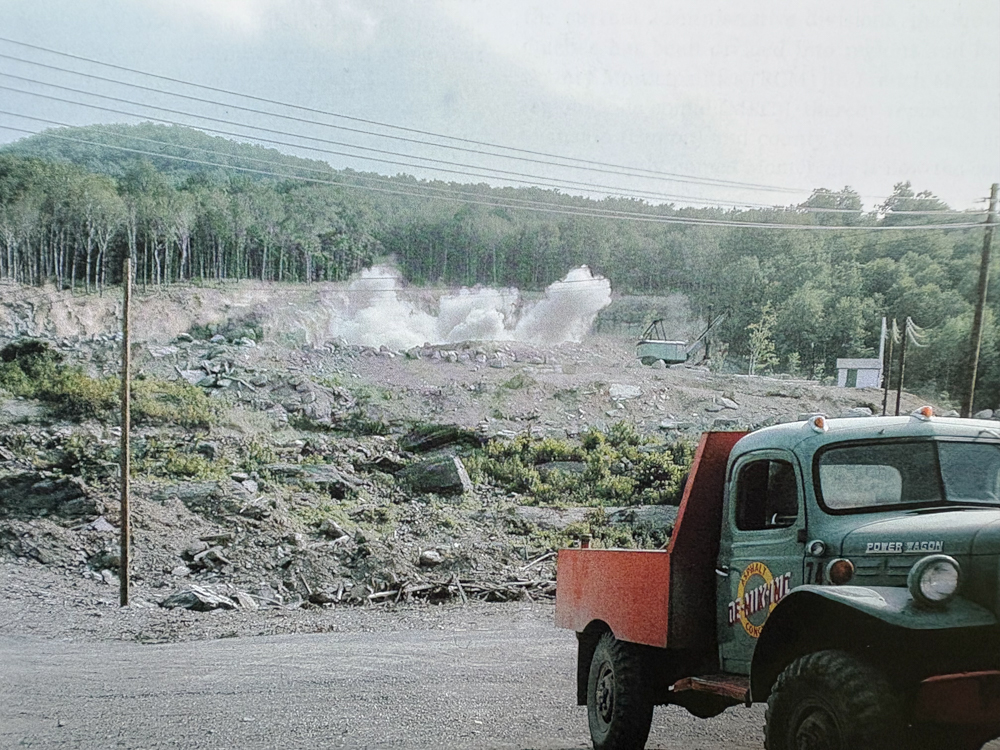
Desourdy Quarry, Mont Saint-Hilaire, 1963. One of the earliest photos of the quarry operations.
Peter Tarassoff photo – Frank was standing with him when he took this photo.
In those early days, Frank was going to Mont Saint-Hilaire at least once a week, and he had a good relationship with the people at the quarry, who appreciated that Frank made a real effort to speak in French with them. Frank sometimes collected at the quarry with other collectors, including Peter Tarassoff (who is considered the “Dean of Mont Saint-Hilaire Collectors”, thanks to over 50 years of diligent collecting and study of the minerals of this amazing place). In the early 1960s, it was only a very small quarry area, into the side of the hill. Frank recalls that the first minerals he found there included green andradite, and sharp little crystals of ilmenite in the pockets with analcime. Frank made the first finds of about 30 of the minerals initially identified at the locality, including many of the greats: serandite, catapleiite, leifite, elpidite and genthelvite. In the early 1960s he began to take specimens to the Ecole Polytechnique in Montreal for identification, by Professor Guy Perrault. Frank was soon contracted by the Ecole Polytechnique to collect research specimens for them, and he also provided research specimens to the National Museum of Natural Sciences in Ottawa (now the Canadian Museum of Nature), to Dr. George Chao at Carleton University in Ottawa and also to the Royal Ontario Museum.
The quarrying operation was split up, in the very early days – the Desourdy operation was down the hill in front, and the Poudrette quarry went up the hill and behind – that’s where the specimens began to come out. Frank recalls the next very early finds were aegirine and ancylite. These were mostly thumbnails micros. And Frank kept going and going. In his first years, there were no other collectors there.
One of the earliest serandites, collected by Frank in 1963 – 5 cm. Formerly in the Peter Tarassoff collection, very kindly gifted to me.
And then came the first serandite, one of the most famous, iconic Mont Saint-Hilaire minerals. Frank first found it while wearing a charcoal grey suit and a necktie. And of course he did what any good mineral collector would do. He stuffed all the pockets full of serandite! He managed to convince the excavator operator to wait for him while he raced up and down the hill to save as many specimens as possible. And then the whole fault dropped and buried the rest.
One of Frank’s great finds in those early days at Mont Saint-Hilaire was the great siderite pocket. Frank sighs when he recalls that pocket, “You could just pull them out, one after the other. The pocket was just full of loose material, and they just kept coming. I went in about 12 ft., collecting siderites with albite.” The pocket was ultimately easily tall enough to stand in and walk in. In those days, Frank drove a Volkswagen Beetle. To transport the siderites, he took the seats out and filled it to the windows with specimens.
At this point in the story, Frank’s description begins to sound a bit suspect, so I asked “Um, Frank, you _did_ pack them carefully, though, right?” Silence. I pressed on, “I mean this was one of the greatest siderite finds from anywhere, ever… please tell me you packed them properly.” Frank: “They got _slightly_ wrapped”. Although there are no photographs to back me up, I have the impression that the loose material of the pocket became loose material filling that poor VW Bug to the edge of drivability…
Siderite with albite, 10.8 cm
One of the most remarkable finds Frank and Wendy made at Mont Saint-Hilaire was Wendy’s opening of the now-famous willemite pocket of August 1968, which included both the large willemite and several small gemmy blue willemite crystals in the collection of the Canadian Museum of Nature.
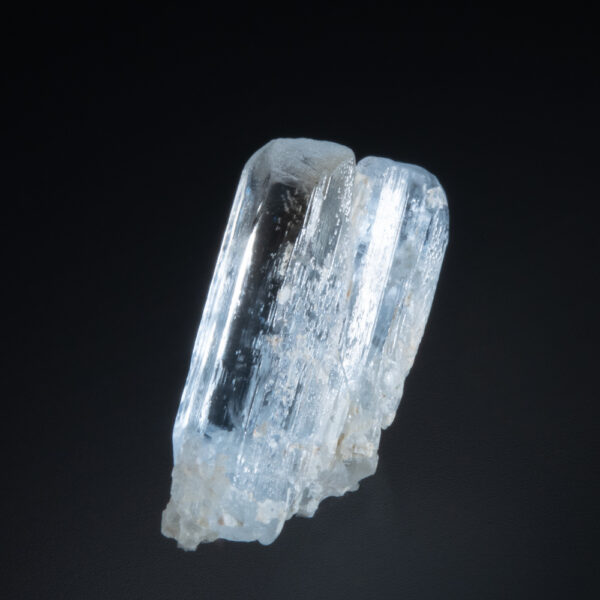
Willemite from the August 1968 pocket – 1.9 cm
Frank and Wendy Melanson specimen.
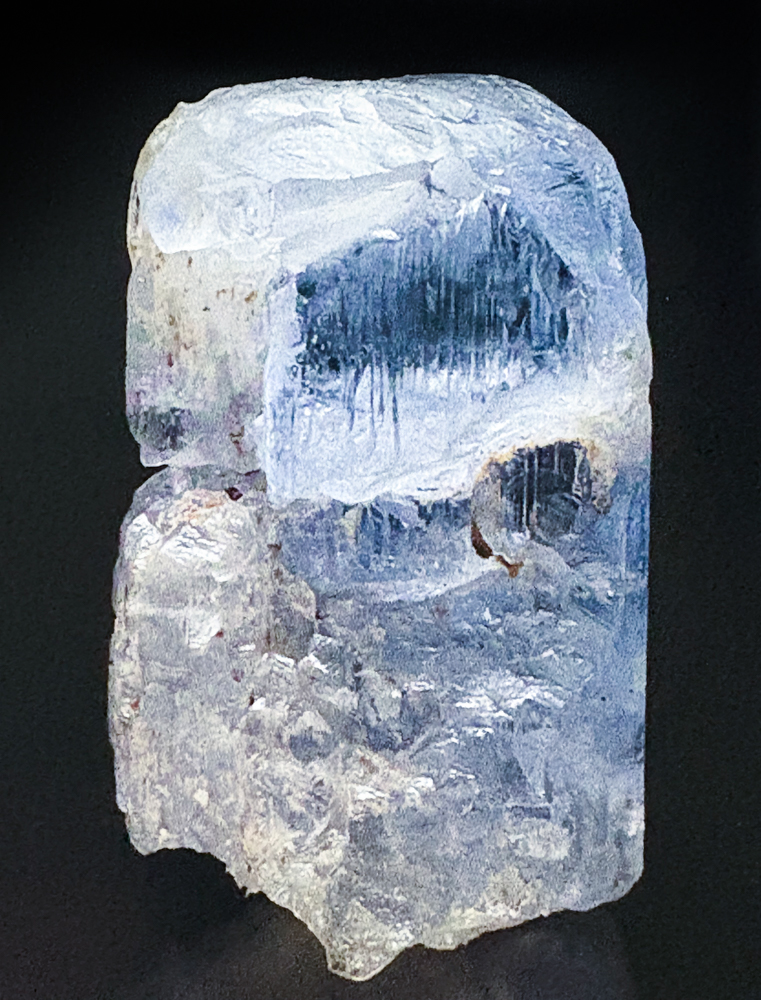
Willemite from the August 1968 pocket, 2.5 cm
Canadian Museum of Nature specimen, Michael Bainbridge photo.
Over his time collecting at Mont Saint-Hilaire, Frank is credited with having discovered the first three new species at the locality: lemoyneite, yofortierite and steacyite, and also, later, gjerdingenite-Na. In honour of all of his early work at Mont Saint-Hilaire, the new mineral, melansonite was named after Frank. (Melansonite is in the rhodesite group, with the formula Na◻KZrSi8O19 · 5H2O; for context, monteregianite-(Y) is a related Mont Saint-Hilaire mineral). The sodium analogue, natromelansonite, is also named after Frank.
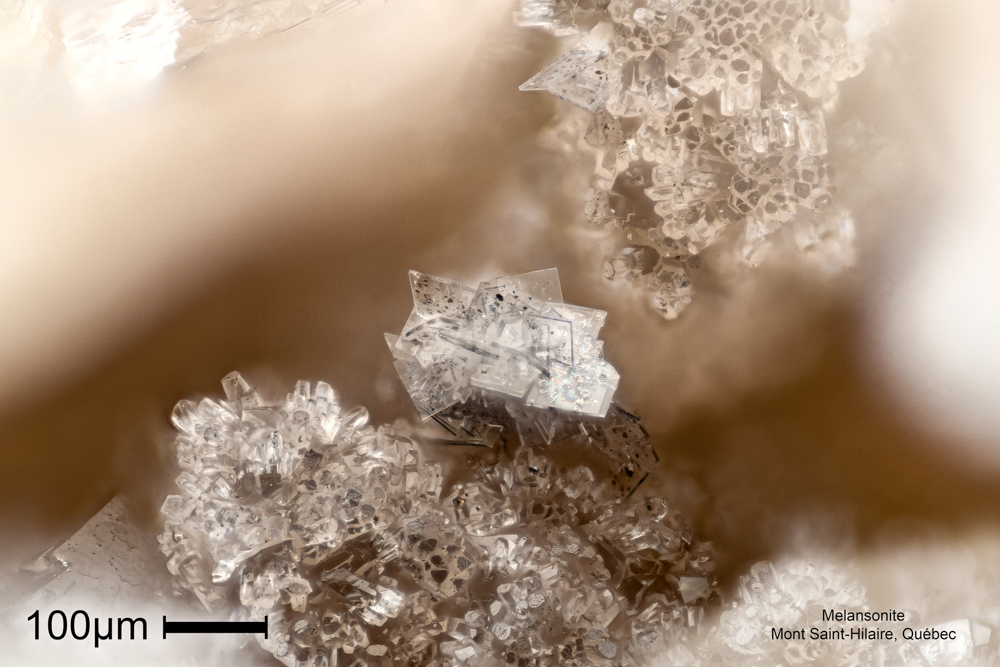
Melansonite – Canadian Museum of Nature specimen, Michael Bainbridge photo.
Frank also discovered, together with Alain Robin from the Ecole Polytechnique, the very top of the famous serandite pegmatite zone that led to the big pocket of 1973 (the “Bouhelier pegmatite”). He collected only one specimen that evening, and didn’t go right back – ultimately that pegmatite occurrence was enlarged and extended, by other collectors and also by the National Museum staff. This pegmatite produced the most iconic specimen Mont Saint-Hilaire has ever produced, known as “The Roller Skate” (the cover on the MSH book, below).
Frank continued to collect regularly at Mont Saint-Hilaire – Wendy began collecting there with Frank in 1967 and they were avid collectors at the locality until they moved to Ontario in 1971.
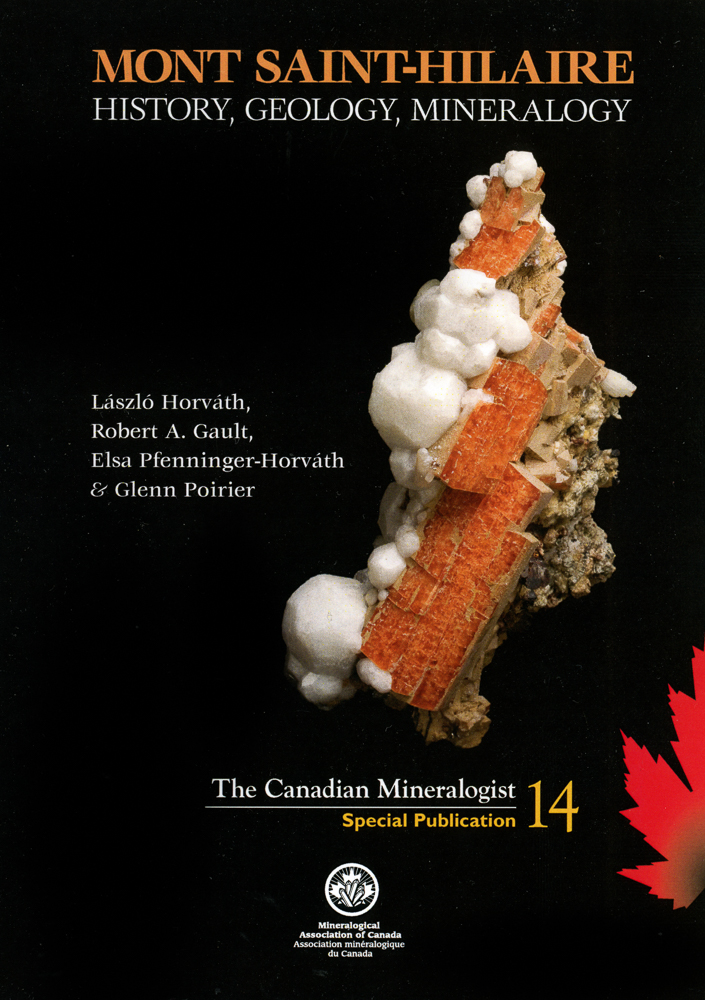
Serandite with Analcime (“The Roller Skate”), Mont Saint-Hilaire, Quebec, 22.5 cm.
Collected in 1973 by Roland Bouhelier, Canadian Museum of Nature specimen, Michael Bainbridge photo.
As a short side note before I continue with Frank and Wendy’s story, the history, stories and mineralogy of Mont Saint-Hilaire (near and dear to my heart and the hearts of many readers) is clearly far beyond the scope of what I’m writing here. This above is a truly fabulous book! In my opinion, the best written about any locality. A updated second edition is currently being written.
Wendy
Wendy was born Wendy McIntrye in Kirkland Lake, in northern Ontario in 1939. Her father was the Chief Engineer at the Kerr Addison Mine. At the time Wendy was born, they were still living in the hotel in Kirkland Lake, as no town had been built at the mine. When the first five houses were built, Wendy’s family moved into House #2. However, as no more of the town was built until after the war, Wendy went to live with her grandparents in Hamilton, Ontario. In 1946, Wendy’s parents moved to Toronto, where her father became the Chief Engineer of the Toronto Transit Commission, where, among other things, he oversaw the construction of Canada’s first subway system.
Wendy trained as a nurse at St. Michael’s Hospital in downtown Toronto (1958-61), and she first worked as a nurse in Bella Coola, in British Columbia, then at Toronto’s SickKids – The Hospital for Sick Children and also at Toronto General Hospital. She also lived in England while taking a program on midwifery. Back in Toronto, she made the fateful decision in April 1967 to go to Montreal to see the world’s exposition of 1967, Expo ’67…
Frank and Wendy
Frank and Wendy met at in the rain at Expo ’67. They were both caught outdoors in a sudden heavy downpour, and when they got under a sheltered roof, Frank said “You look like a drowned rat. Can I buy you a coffee?”
Like Frank, Wendy truly loves minerals. However, she didn’t know that when they met – she had never been exposed to beautiful mineral specimens. In June, 1967, Frank and Wendy travelled to the National Mineral Show in Washington, D.C., and she fell in love with minerals. People would later joke that Wendy married Frank for the minerals… something she still today talks about with a hearty laugh in the telling.
Early Field Collecting and Acquiring Together
Frank and Wendy enjoyed field collecting the local region – in addition to Mont Saint-Hilaire, they made trips to the quarries at Belvidere Mountain, Lowell, Vermont (colloquially sometimes referred to in the collecting community as “Eden Mills”). In the late 1960s, they would drive down and pitch a pup tent – they recall one trip where they unintentionally pitched the tent in what they discovered was a drainage depression, and they woke up in two inches of water… At Belividere Mountain, they collected beautiful grossular, diopside and clinochlore crystals.
And, speaking of grossulars, of course over the years, they chased down many superb specimens of grossular (along with the other minerals) from the Jeffrey Mine in Asbestos (now renamed Val-des-Sources), Quebec, including some of the finest known. One such specimen became their mineral dealing logo (see below).
Grossular, Jeffrey Mine, Val-des-Sources, Quebec – 9 cm
A highlight of their Canadian collection, this was the Hawthorneden logo specimen in later years.
Now in the Robert Beckett Collection.
Frank and Wendy recall that in the early 1970s they acquired the contents of a large pocket of grossular specimens from the Jeffrey Mine (the same pocket that produced the logo-specimen, above), and so they made their first driving trip to the Western US to sell minerals. Famous mineral wholesaler Susie Davis was “too busy to see them” (in retrospect: oops! (!!!)), and so they drove to California and met with Bill Larson, who acquired the lot of grossulars.
Other field collecting ventures in Quebec included the Francon Quarry in Montreal (famous as the type locality for weloganite) and the Orford Nickel Mine in Saint-Denis-de-Brompton, known among collectors for super diopside crystals, among other minerals (and even more significant in the mining world as the humble birthplace of the Canadian nickel mining giant, Inco).
On a collecting trip together to Bathurst, New Brunswick, Wendy collected this wonderful sphalerite specimen:
Sphalerite (Spinel Twin), Brunswick Mine #6, Bathurst, New Brunswick – 3.5 cm
Collected by Wendy in 1970, now in the Robert Beckett Collection
Ontario and Full-Time Mineral Dealing
In 1971, Frank and Wendy moved to Ontario, initially living in the Leaside district of Toronto, and soon moving to the small town of Madoc, about 2 hours’ drive east of Toronto. Madoc had historically been a fluorite-mining town, so it was fitting that Frank and Wendy began their mineral dealing there. Although mineral dealing became full-time for both of them, for the first seven years of mineral dealing, Wendy worked in Madoc, first as a special education teacher and then as a nurse at the nursing home there.
Frank sorting specimens in Madoc, 1972
From 1973-1991, they grew the business into a prominent international dealership from their home base in the tiny Ontario town of Bannockburn (about 40 minutes’ drive south of Bancroft). Part of the house was the shop, and they began to do more and more mineral shows.
In 1991, they completed their home just outside of Bancroft and have been based up here ever since. Wendy is an amazing gardener and their property hosts truly spectacular perennial gardens!
Canada Collecting Projects
In the early years, Canadian collecting projects were a particularly important source of specimens. During much of this time, Frank collected together with his good friend and collecting partner, George Robinson. (George was a wonderful guy! One of the kindest people in the mineral world, an early mentor of mine who was the first to teach me about mineral photography, and who would happily sketch out maps to lead me on my next collecting adventure.) Frank and George worked on several smaller projects in the Wilberforce and Tory Hill areas of Ontario, and they partnered on two larger multi-year projects, Thunder Bay and Otter Lake.
Frank and George made a number of trips up north to the Thunder Bay District of Ontario to work the amethyst deposits. On one memorable trip, in July 1978, they brought back an estimated 7,000 pounds of amethyst specimens in an old blue cargo van and… they blew out two tires. They couldn’t jack the van with two jacks, so they had to dig it out instead (!)
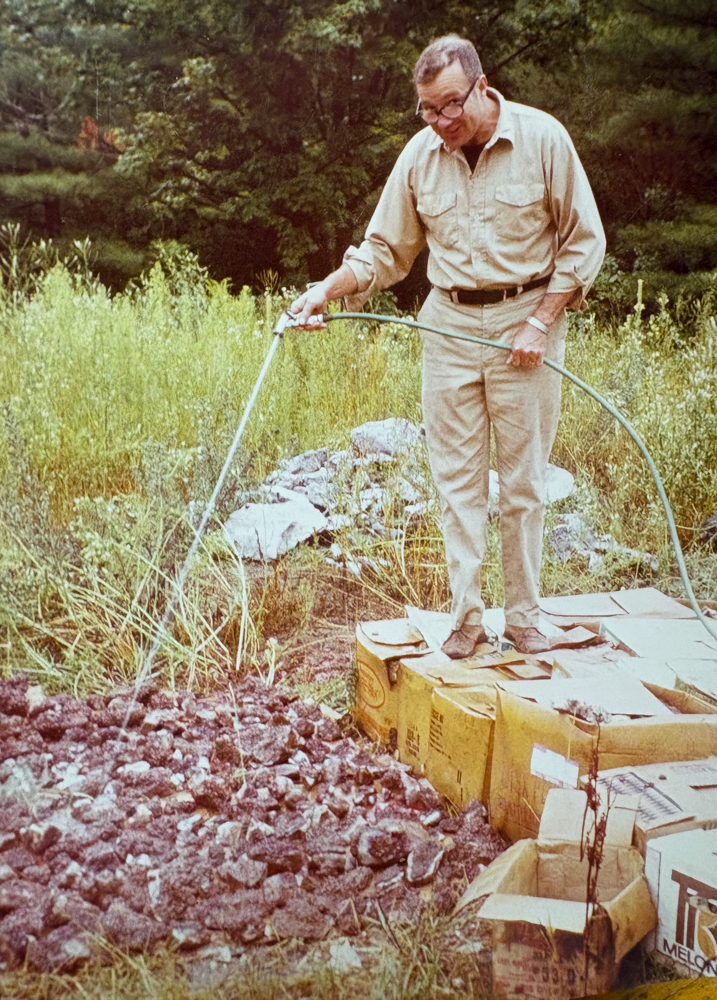
Frank standing on boxes of amethyst, cleaning amethyst
July, 1978
Frank and George carried out a lot of work at the famous Yates Mine near Otter Lake, Quebec. Frank did this the first year with Jean-Charles Sisi from Ecole Polytechnique, and they set off a large dynamite blast. The following few years, Frank and George produced many fine specimens at the locality, notably superb specimens of the classic green fluorapatite in orange calcite.
Buying Abroad
Over the years, Frank and Wendy traveled the world buying mineral specimens. They bought all over Europe, including in the days of dark back-alley transactions at Panasqueria, and they also went further abroad, including to India and Nepal. However, Hawthorneden’s business over the years involved large numbers of specimens from two countries in particular: Brazil, and to a lesser degree, Romania.
Specimens from Brazil
Beginning in the early 1980s, Frank travelled extensively in Brazil for specimens over a period of more than 30 years.
One of the first trips to Brazil
Minas Gerais, Brazil
With his guides, first Joe Ulcheck and then later his daughter Heliani, he built a network of contacts, particularly all over the state of Minas Gerais, which is home to some of the greatest mineral localities in the world.
Ouro Preto, Minas Gerais, 2005
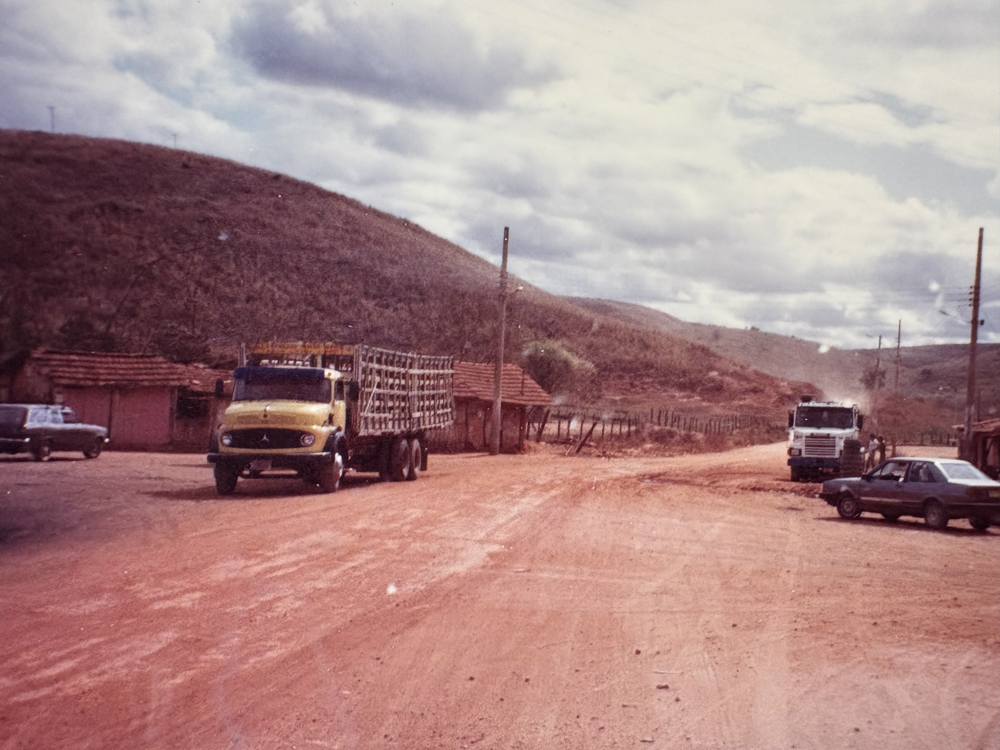
The main highway at Linopolis, Minas Gerais, 1990
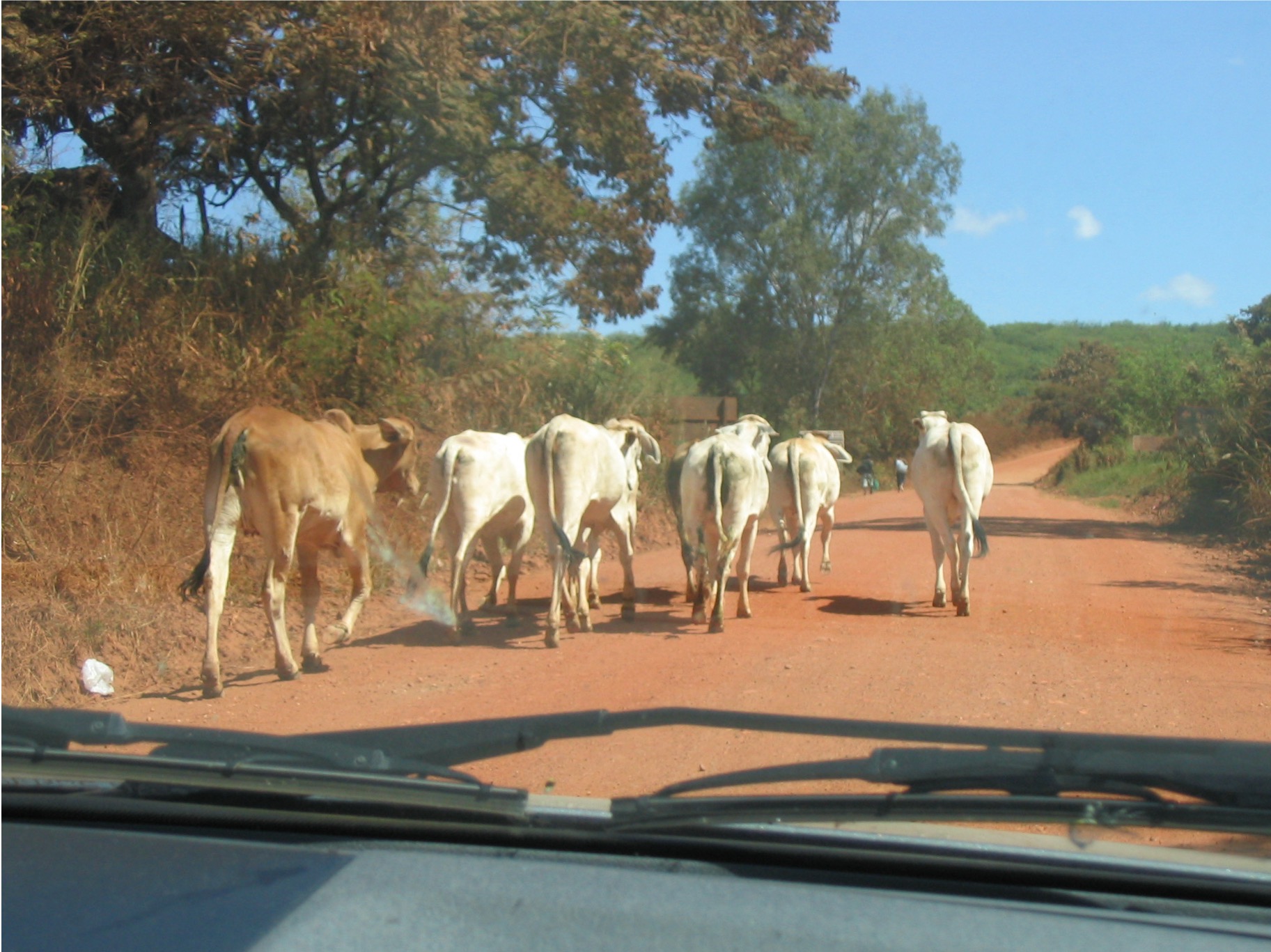
The one highway through this part of Minas Gerais in 2005 – everyone used it, including the cattle!
Frank travelled to the mines – and to the homes of mine owners, dealers and miners, in search of specimens. The mining operations were sometimes rather precarious affairs, and as you can see, some miners had nothing in the way of protective gear.
Garimpeiros (miners) underground at the Johnny Ulchek Mine, Minas Gerais

Frank examining a pegmatite underground at the Pierre Laville Mine, Minas Gerais, 1995
Laszlo Horvath photo
A “ladder” of rebar rods, down a vertical descent into a mine in Minas Gerais
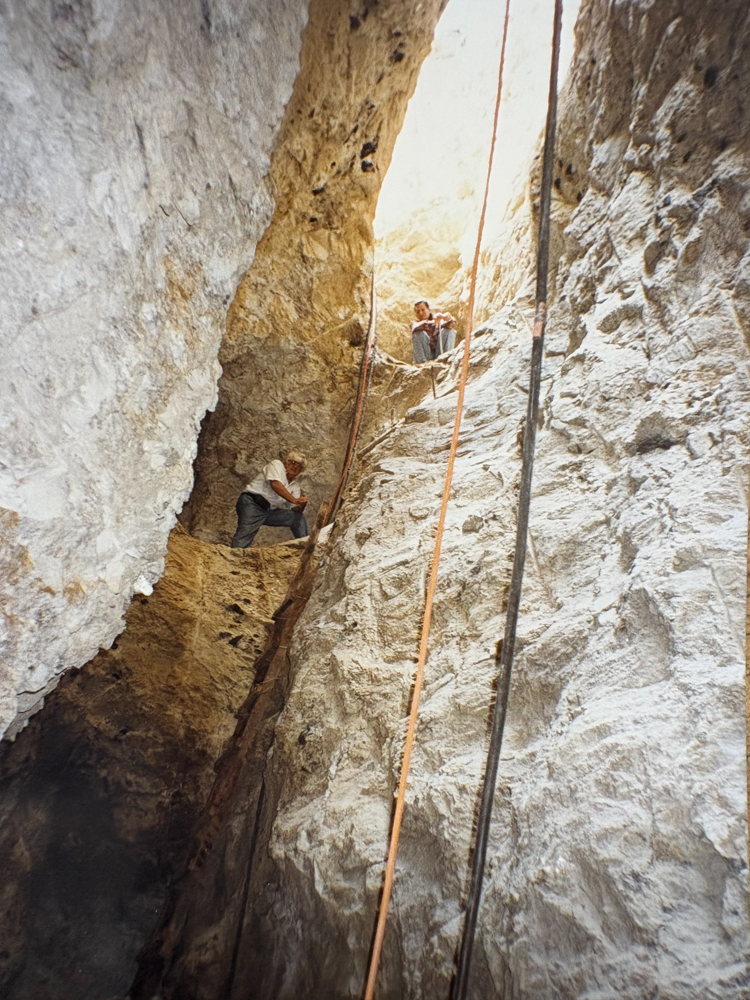
At the famous Urucum Mine in Minas Gerais, with good friend Laszlo Horvath
and Heliani Ulchek (upper), 1995
One major challenge that persisted throughout Frank’s years of buying in Brazil was finding specimens that were truly fine mineral specimens, free of damage. Some of this was due to the speed and lack of care when collecting. However, when I travelled with Frank in Brazil, I was amazed at the way so many sellers would simply pile as many pieces as would fit onto any given horizontal surface… guaranteeing some damage at least…
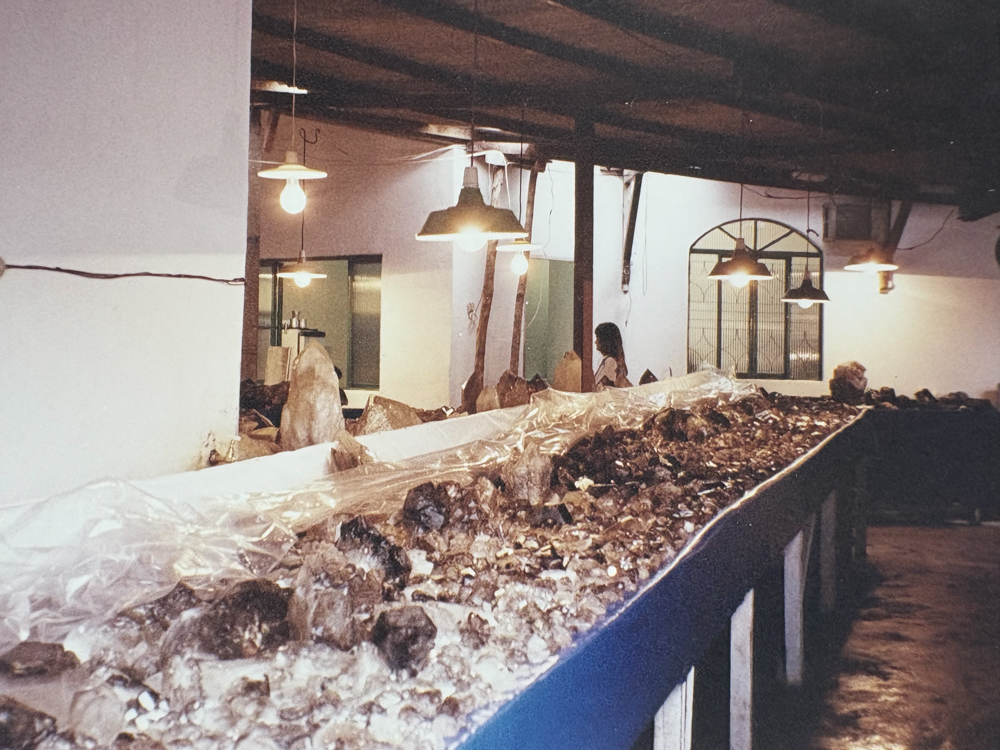
As much smoky quartz as could be squeezed onto these tables (!)
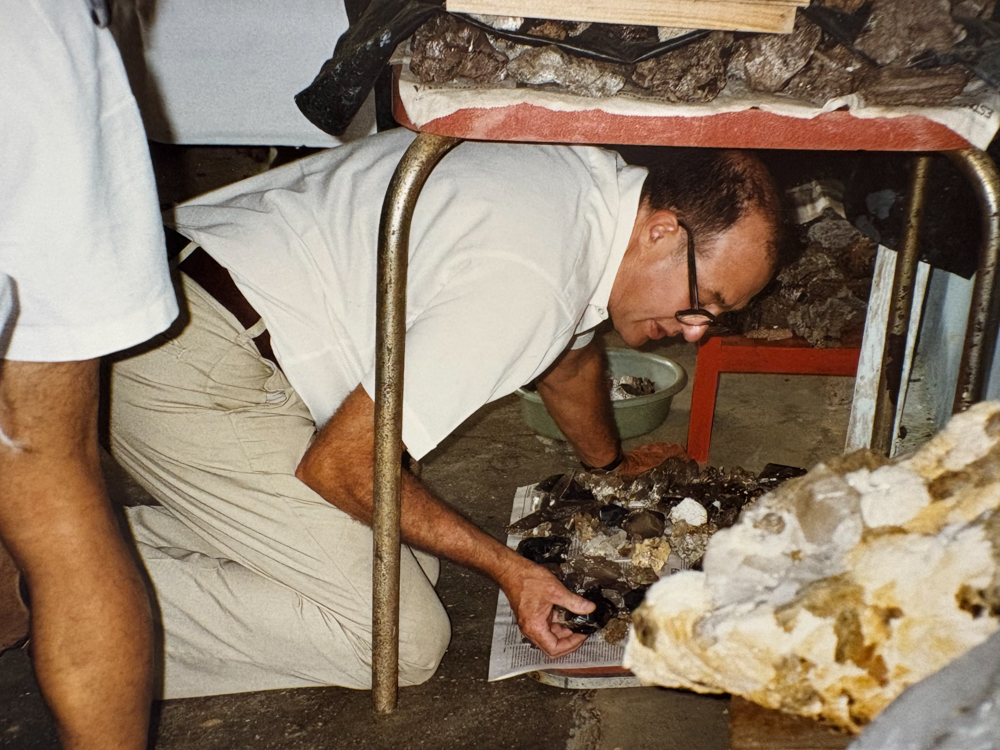
Frank, on an urban field collecting expedition under a table, Conselheiro Pena, Minas Gerais, 1995
Laszlo Horvath photo
Some of Frank’s acquisitions were from outdoor street vendors, particularly in Governador Valadares.
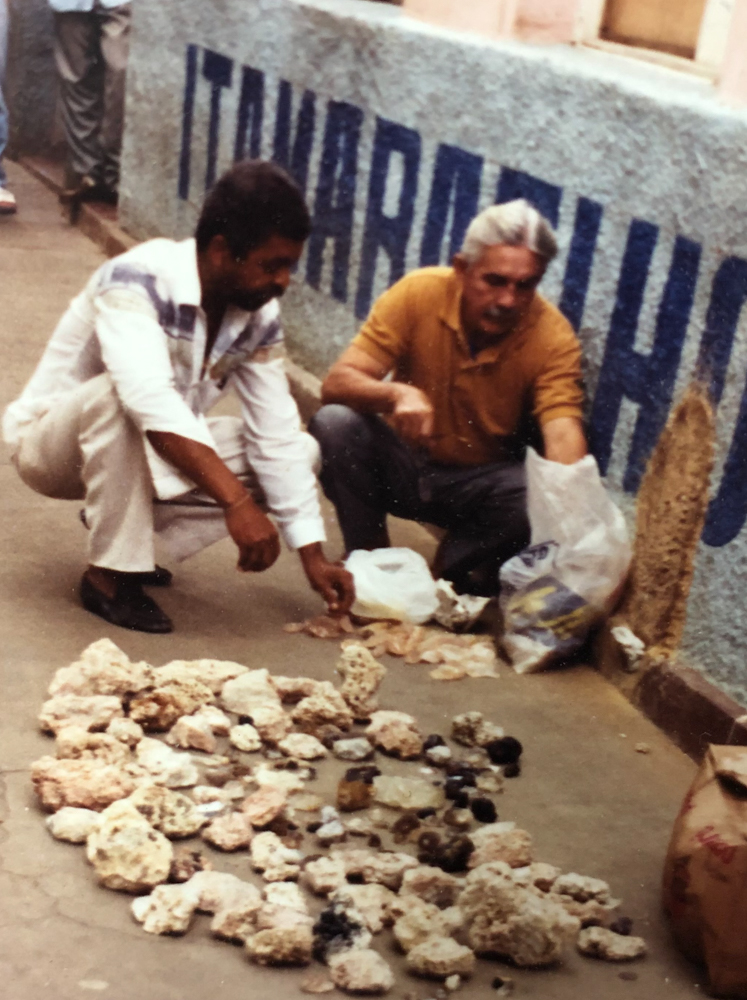

Street vendors, Governador Valadares
(Note, mineral specimens squeezed all together, on top each other getting damaged… sigh…)
In later years, Frank was well enough known that he would simply set up shop at a table outside the pool hall and dealers and runners would bring specimens to him.
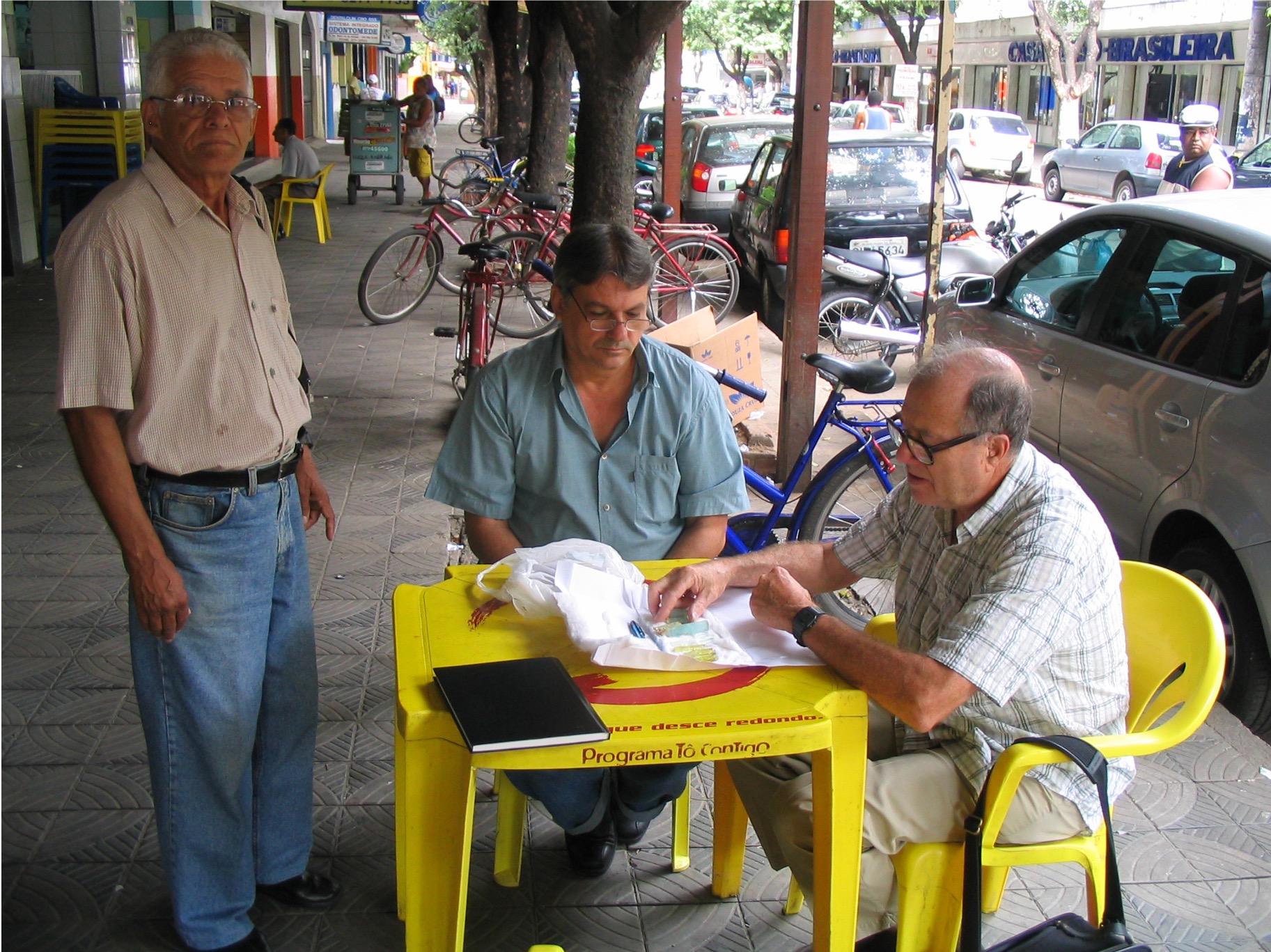
Frank’s office by the billiards hall in Governador Valadares
To give you a sense of the nature of these transactions, the seller in the above photograph brought a small lot of beryl crystals (Rochester Symposium pen for scale!):
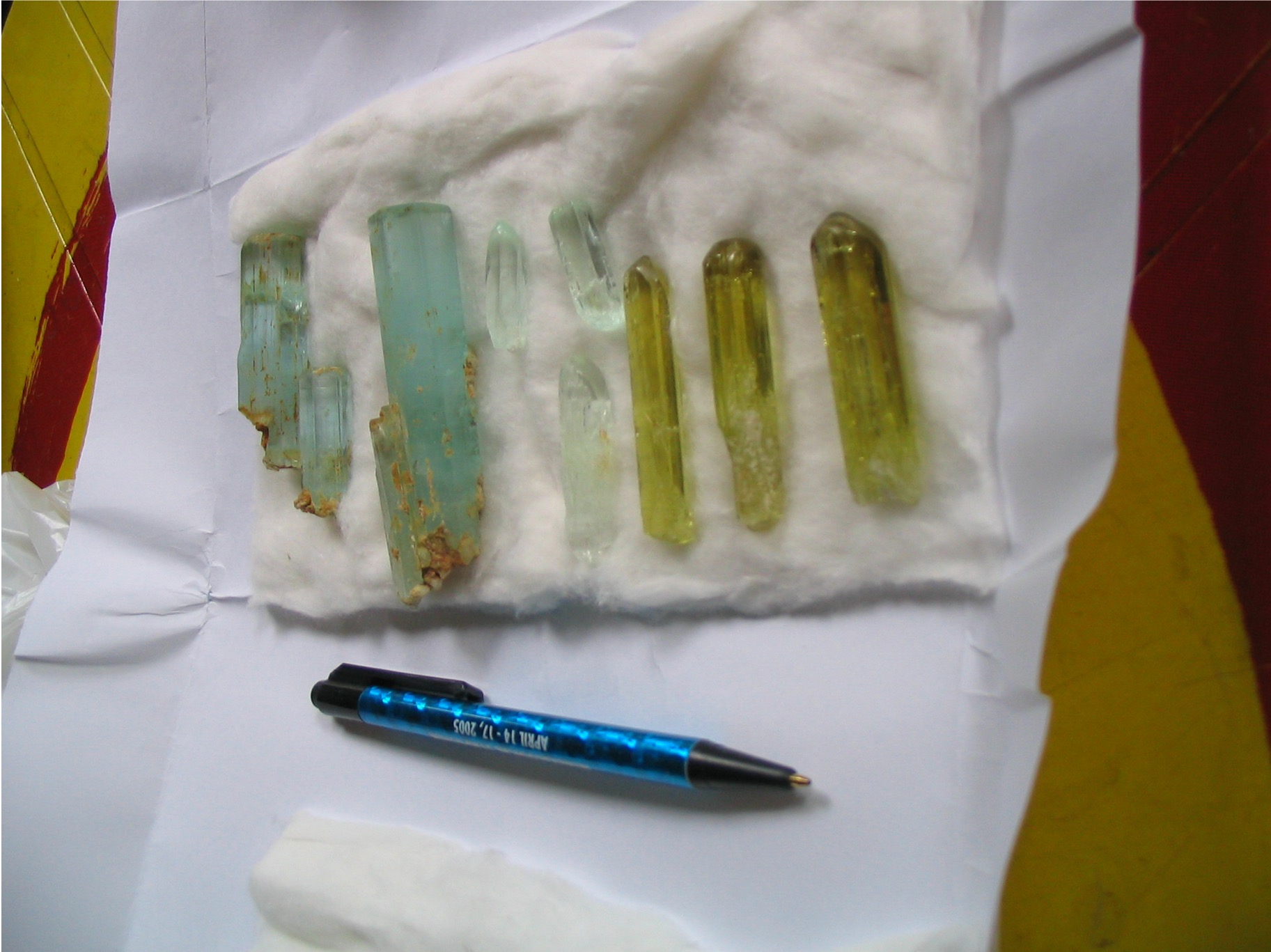
The vendor’s lowest price for these was higher than we would have paid retail in Canada or the US for these same crystals (!), so there was no thought of a transaction. By this time (2005), the internet was already spreading delusions of grandeur to in-country mineral sellers. We also had some hesitation about the three “heliodors” on the right. The mine in question had not previously produced heliodor specimens, and these crystals are a particular hue that left us uncertain as to whether they were naturally that colour or had been irradiated to fetch a higher price (heliodor fetching a higher price than aquamarine).
Although there were occasionally good specimens to be bought from the street dealers and runners, most acquisitions were made by meeting the various contacts in his network, visiting them at their homes and negotiating to buy specimens.

Examining Emilio’s tourmalines, 1995
Laszlo Horvath photo
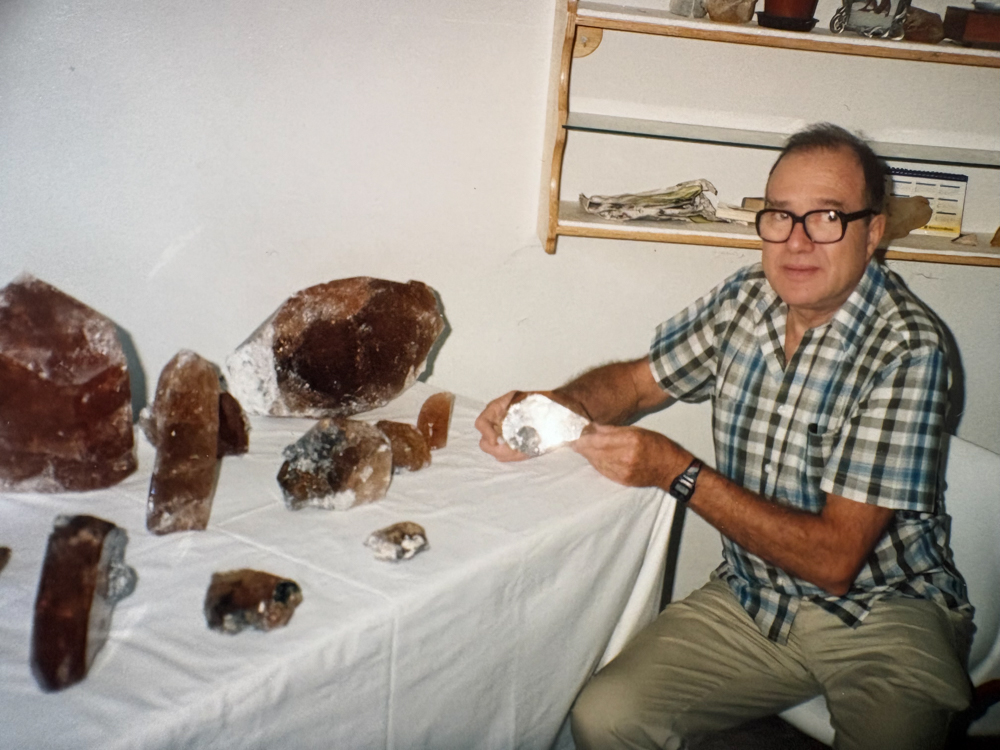
Morganite specimens at Aracuai, Minas Gerais, 1997
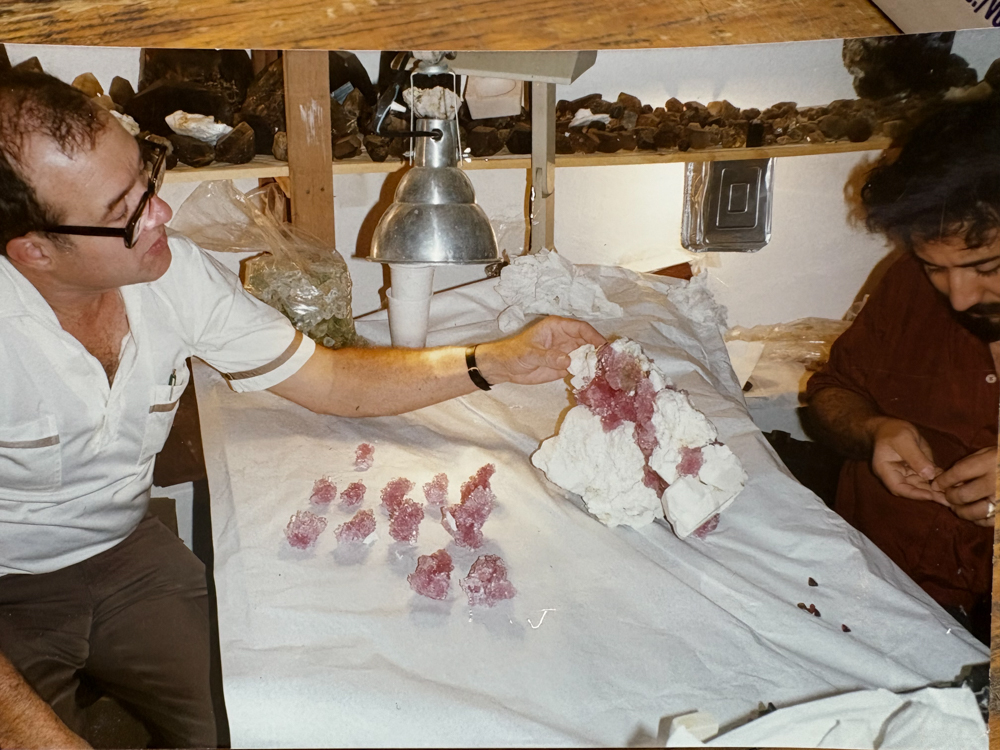
Evaluating rose quartz lot, Minas Gerais
Frank brought thousands of fine specimens back from Brazil, including some of the important pieces of this time period, and these specimens are now in museums and collections worldwide. His first major acquisition was a good-sized lot of green elbaite from the “first era” workings at the Pederneira Mine. Frank fondly remembers that other significant acquisitions included a hand-sized blue topaz from Virgem de Lapa and three of the good Medina aquamarine crystals. In later years, Frank – sometimes working together with his good friend and partner, Luiz Menezes, handled some incredible material, including many of the top spessartines from the Navegadora Mine, superb brazilianites and montebrasites from the Telerio Claim, the heliodors from Padre Paraiso, the bi-coloured and purple fluorapatites from Golconda, the rutiles from Buritis and the incredible find of fluorapatites at the Sapo Mine (which Frank regards as the second top single find they were involved in, over the years). I’ll save those stories and wonderful specimens for another time. But the story of what Frank regards as the other top find must be included here…
In 2004, Frank learned of the superb lot of rutile-hematite from Novo Horizonte, in Bahia. The seller was keeping the lot under his bed until Frank and Luiz arrived. And although the epitactic rutile on hematite from this locality had been known since the 1980s, the 2004 pocket was different. Whereas most specimens from Novo Horizonte had been fairly small, and the rutile crystals from there are usually incredibly fine hair-like needles, the specimens from this pocket included spectacular crystal groups and the rutiles are more robust, with discernable terminations. This pocket contained a piece that is, in my opinion, one of the greatest mineral specimens, of any species, of all time. The following two photographs are the lot, as shown to Frank and Luiz in Brazil:

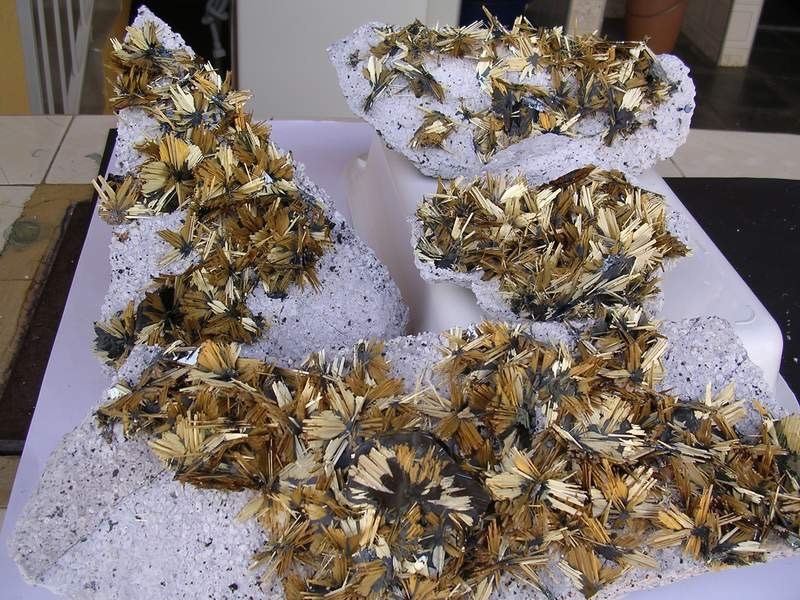
It’s impossible to make out how good these really are in the photographs above – taken when Frank and Luiz first saw the specimens in Brazil – and at that time they were not yet cleaned and prepped. But to give you a better idea of the wonderful top specimen I mentioned above, it’s the one in the lower part of the photo above, and below here is a photo of it as it now is, in the MIM:
Rutile on Hematite, Novo Horizonte, Bahia, Brazil – 40 cm. MIM specimen, Wendell Wilson photo.
Specimens from Romania
Although Brazil was Frank and Wendy’s single largest source of specimens over the years, and Frank’s in-country travels in Brazil far exceeded others, in the 1980s and 90s Frank made numerous acquisition trips for Romanian mineral specimens. He brought back many superb specimens, from highly aesthetic relatively common species to rarer minerals.
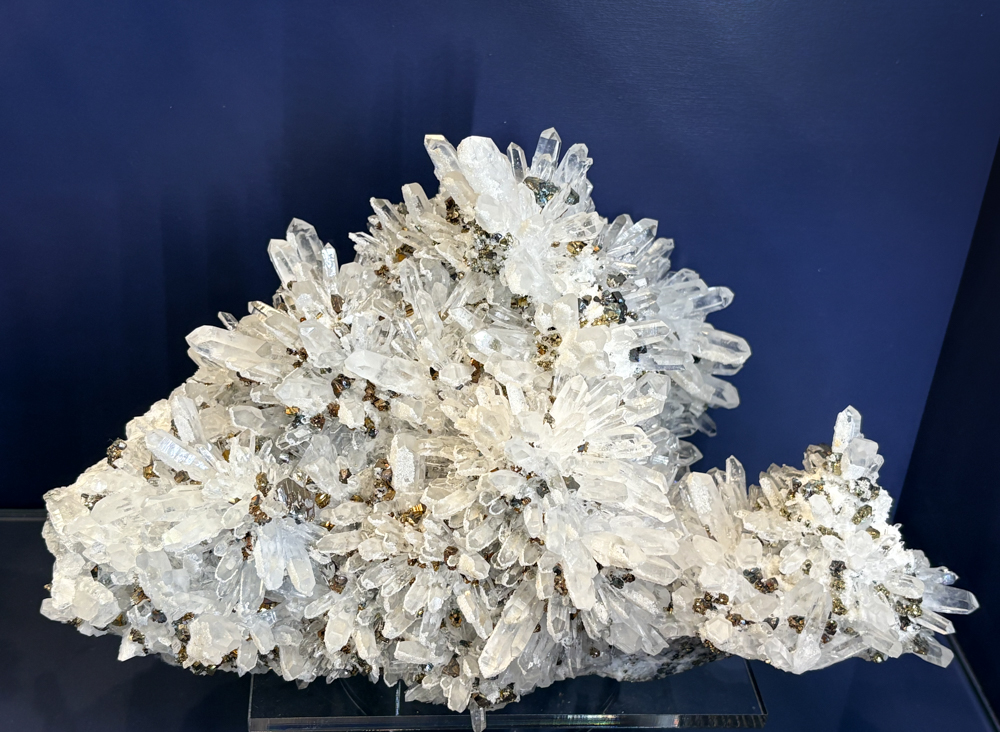
Quartz with chalcopyrite, Cavnic Mine, Cavnic, Marmures County, Romania – 27 cm
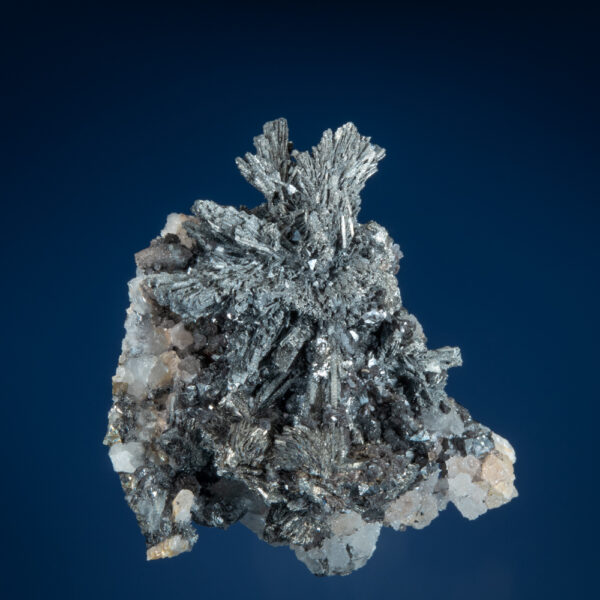
Fizelyite crystals with minor semseyite, Herja Mine, Baie Mare, Marmures County, Romania – 4.7 cm
These expeditions were among the most colourful of all of Frank’s travels. In the 1980s, even before the fall of the Iron Curtain in 1989, it became possible to acquire mineral specimens in Eastern Europe. And indeed there were superb specimens to be had, including in Romania. In those years there was considerable economic upheaval in the countries of Eastern Europe, accompanying the ongoing political upheaval. And Frank perceived that there was good opportunity to acquire specimens from the famous mining areas in Romania, so off he went – in total, he made about a dozen trips there. His first trips were to Hungary, Czechoslovakia and Yugoslavia (as the latter two were, at that time) to buy Romanian specimens. And then after 1989 he was able to travel in Romania. At the time, it took anywhere from six to sixteen hours to simply cross the border to get into Romania. Early in his Romania travels, Frank noticed that the diplomats got through much more quickly driving standard black Mercedes vehicles. So Frank learned to travel in a black Mercedes like the diplomats used, and would join the government convoy to jump the line.
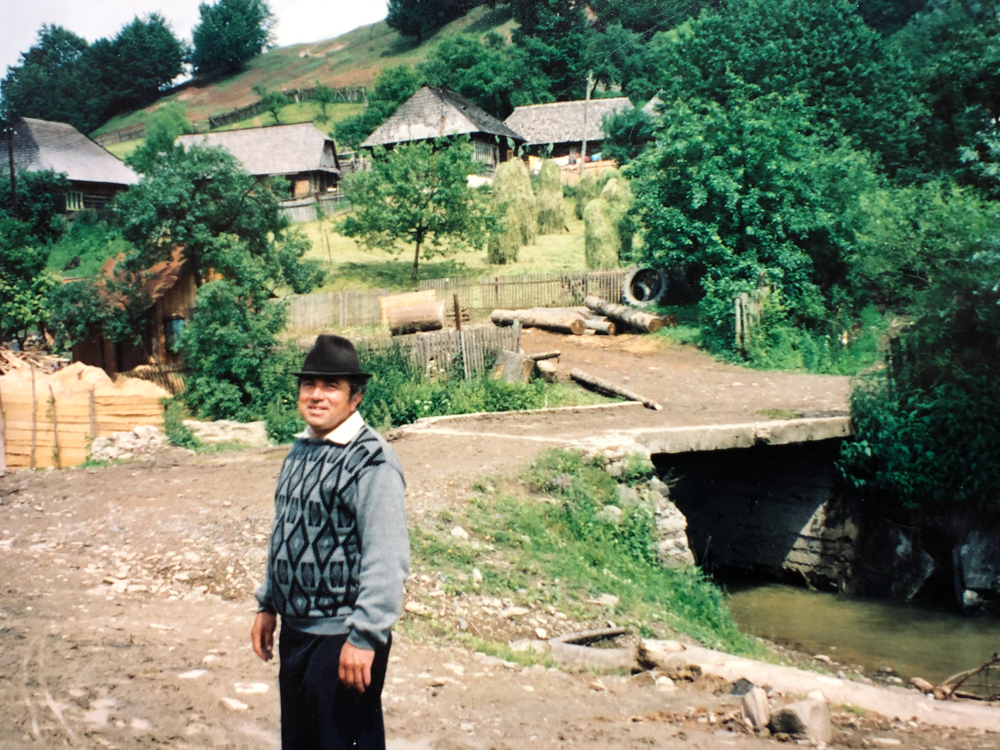
Resident of a small mining district town north of the Herja Mine, Romania
Frank’s guide, translator (and a good source of specimens) was Istvan, the nephew of Les and Elsa Horvath, and in later times Istvan’s common law partner Gizella would sometimes work for Frank in that role.
These were complicated times in Romania. There were rules, there was a level of chaos and a level of corruption. It is safe to say that if you have any specimens from Romania in your collection that date back to the 1980s and or 1990s, they probably came out of the country without full “proper clearances.” This is not to say that it was not legal to buy mineral specimens in Romania and export them – it was. _Technically._ The problem was that it was rarely feasible or possible to obtain those clearances. So, a practice evolved where sometimes people were paid for “services rendered” and one’s specimens were picked up on the other side of the border in Hungary.
On one of these trips, Frank found himself in a disagreement with local authorities and it got ugly. It was initially asserted that Frank was to be detained (things were cleared up and all was well). In Frank’s telling, “I got yelled at. And I yelled back. When I got home and told Wendy, I got yelled at. And in that instance I didn’t yell back.”
During another Romania trip, Frank bought a collection of a couple hundred specimens. As had become the norm by those days in the 1990s, someone was paid to ensure that the specimens made their way out over the border with Hungary. In this case, the person ferrying the specimens had unpacked the specimens, planning to highgrade the best specimens out of the collection and give less than all of them back to Frank. T0 cross the border, this person then spread all of the specimens all around hidden places in the car, including under the hood. When Frank intercepted him, he found the specimens all over the vehicle, including on top of, and around, the engine. Although some specimens got damaged, most survived well. By the time it had come to this, Frank decided he was done with Romania. Frank recalls, “We never went across that border again, because it was said that people were being disappeared or were jailed until payments were made.”
Hawthorneden, Shops and Mineral Shows
Of course, the mineral dealing business is about a lot more than the first steps of procuring the specimens in the field or abroad. Back in Canada, Frank was an expert with cleaning and prep techniques. And it was Wendy who looked after many of the other aspects of the business, including the logisitics for inventory, pricing, all the labeling, displays, the shops, and organization for the many mineral shows where they sold specimens. Hawthorneden was a business that depended equally on both Frank and Wendy, and they ran it successfully for over 40 years.
First in Bannockburn and then Bancroft, Frank and Wendy had shops attached as part of their homes, and when they were not out on the road, one could have a nice visit and peruse beautiful specimens. However, the phrase “when they were not on the road” is doing a lot of heavy lifting. Frank and Wendy were on the road a LOT!
Frank and Wendy began setting up at shows in the 1970s.
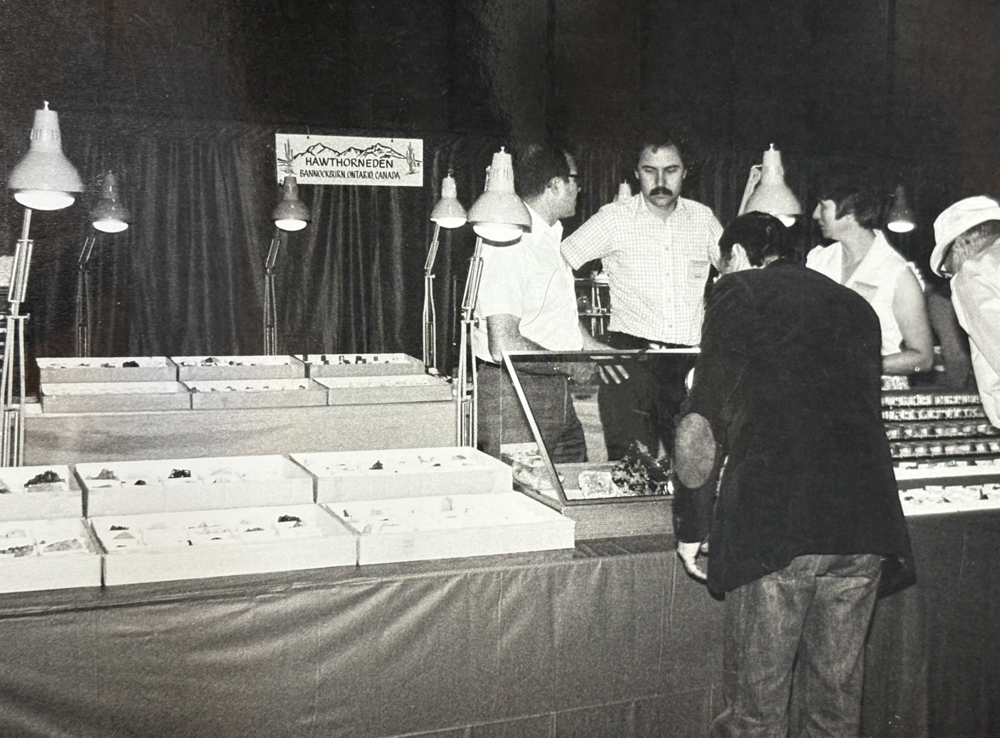
At Tucson, talking with Joe Nagel, who worked for Frank and Wendy in Tucson for years
At the height of their business, they’d be away from home for over 2oo days of the year. Frank and Wendy set up at annual mineral shows all over, including:
Berkeley, California
Faceter’s Fair, San Jose, California
Tucson, Arizona (Main Show)
Hayward, California
Kansas City. Missouri
Buffalo, New York
Rochester, New York – Rochester Mineralogical Symposium (starting with RMS #2!)
Columbus, Ohio
Cincinnati, Ohio
Montreal, Quebec (Club de Mineralogie)
Rochester, New York – Rochester Mineral Society
Bancroft, Ontario (Club Show)
Bancroft, Ontario (Gemboree)
Springfield, Massachsetts
Scarborough, Ontario
Munich
Montreal (Gem and Mineral Club)
In addition, they exhibited once at each of Sainte-Marie-Aux-Mines, Torino, Altdorf (Switzerland) and Zurich.
Wendy, Tom Gressman and Frank, Tucson 1989
Tucson 1999
Tucson 2005
Bancroft Gem and Mineral Club and the Museum
Leading members of the Bancroft Gem and Mineral Club for decades, Frank and Wendy also led the restoration of the historic Bancroft Train Station, which is now home to both the Town offices and the Bancroft Gem and Mineral Club Museum. It could not have happened without them! Wendy is the curator of the Museum. If you haven’t yet visited the Museum, it’s great and I hope you will. To read more about it, there’s an article on our website, here.
Contributions
Frank and Wendy have made huge contributions in the mineral world. They have personally collected, cleaned and prepped thousands of fine mineral specimens. Traveling the world, they acquired and brought to light many more thousands of specimens that now grace museums and private collections all over the globe – some of these are masterpieces at the level of best-of-species.
Of course Frank’s work in the early years of Mont Saint-Hilaire contributed to a major advancement for mineralogy, preserving many early specimens of rare species and collecting excellent specimens from one of the most important localities ever known.
Frank has not only mastered many techniques of specimen preservation, cleaning and preparation, but he has passed on this knowledge too – I have learned a lot from him!
They have engaged with collectors and the public about minerals in many ways. Through all the one-on-one conversations as show dealers, exhibiting their collections and rarely even making presentations such as at Rochester, Frank and Wendy have encouraged new and young collectors, sharing their enthusiasm and knowledge. Frank was a founding a and active member of the Montreal Gem and Mineral Club during those early years, and he served as Field Trip Director for three years. Frank and Wendy’s leadership of the Bancroft Gem and Mineral Club and their establishment of the Bancroft Gem and Mineral Club Museum – have also had the goal of sharing mineral knowledge and encouraging new and young collectors, along with educating the general public.
I first met Frank and Wendy when I was 11. I am an example of a once-new and once-young collector they encouraged (and look what happened there!!!). Near the end of their dealing career, Wendy once introduced me to another collector as “One of our oldest customers…” [and then, laughing] “…I mean, in terms of years of buying from us, not age.”)
Wendy and I share a very similar taste in specimen aesthetics – we really enjoy looking at minerals together and discussing the merits of each specimen. And Frank and I have talked for countless hours on every subject in mineral world – he is a great mentor. Frank is a straight-shooter, a smart businessman, he can be tough but is always fair, and is a generous teacher.
And of course, for many people, Frank and Wendy are not only huge contributors in the mineral community, they are good friends.
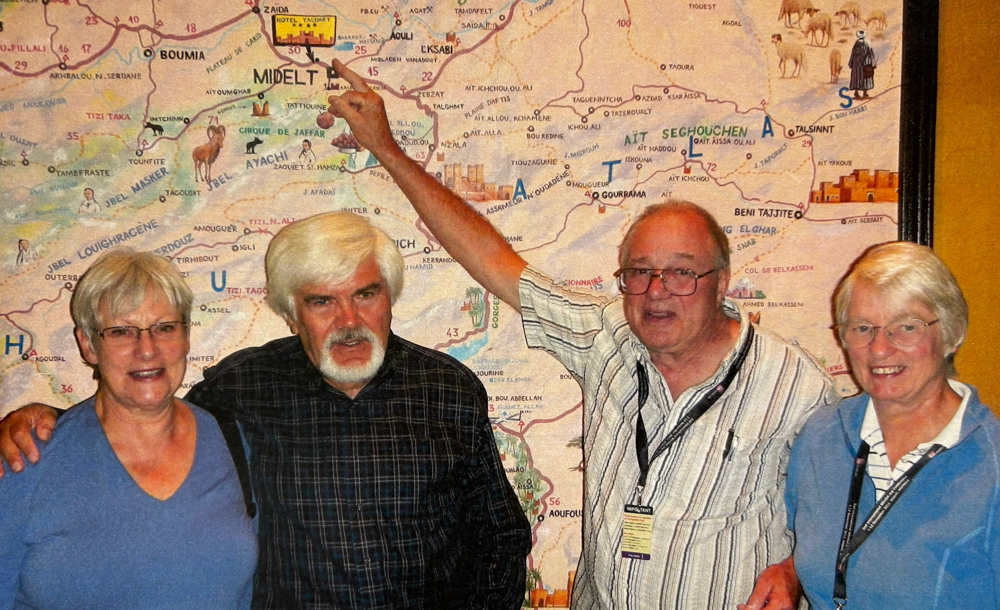
With Les and Elsa Horvath, in Midelt, Morocco
With Ann Frazier

With David Joyce, in Mibladen, Morocco
With Bob Beckett
L. Horvath photo
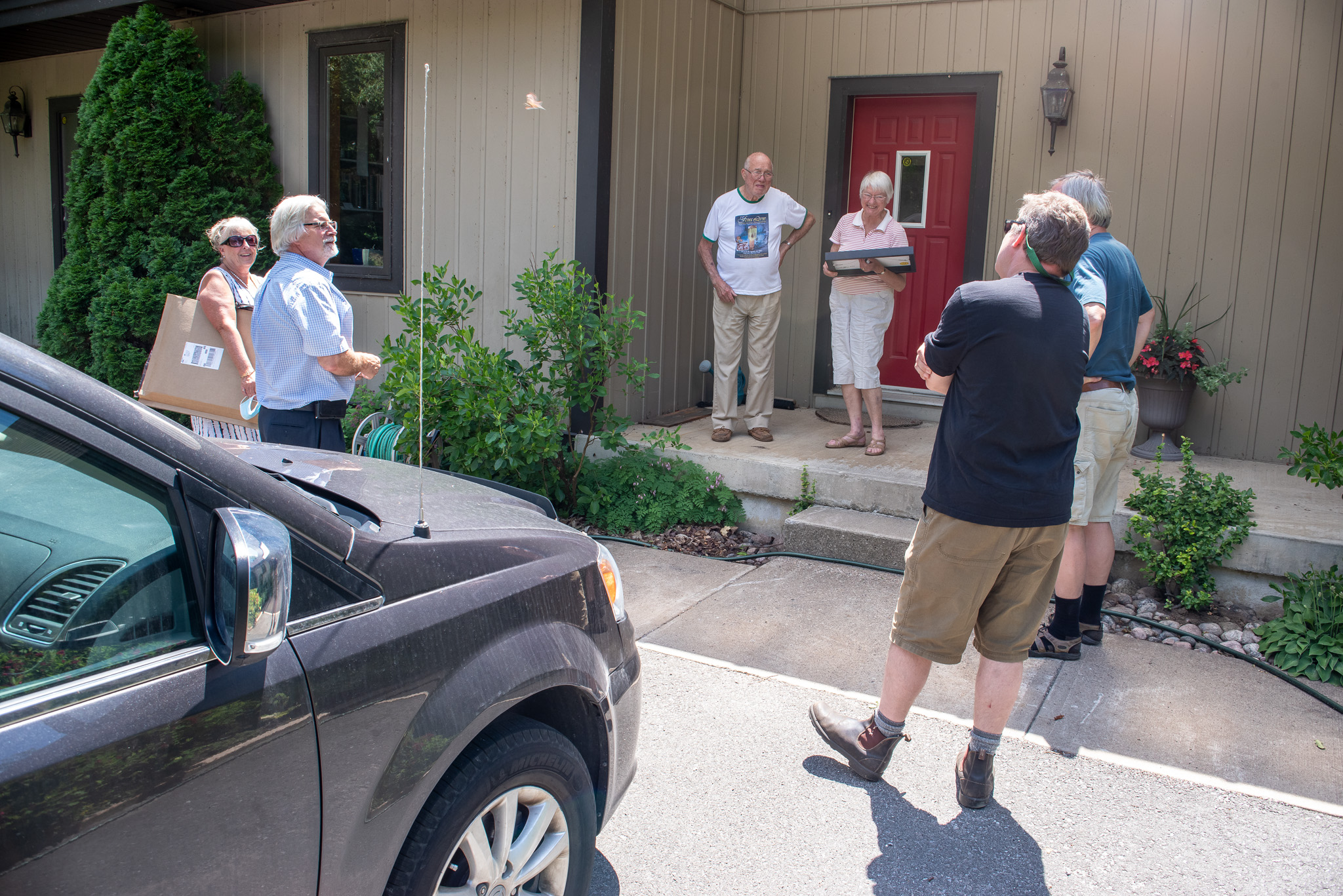
A COVID-distanced moment with friends – Bob and Brenda Beckett (along with David Joyce, Michael Bainbridge behind the camera, and me). Bob and Brenda were presenting Frank and Wendy with a framed print of Michael’s photograph of the melansonite, soon after the mineral had been named.
On behalf of all of us in the mineral world, to whom you’ve made so many contributions all along the way, thank you Frank and Wendy!


